Overview
- Brief Narrative
- Watercolor by Arie Singer depicting 5 scenes from the day his father was killed in the massacres at Ponary forest, April 20, 1942. It is from a series created from 1985-2000 based upon memories and events from his youth as a 13 year old partisan fighter in the forests northeast of Vilna, Poland, (Vilnius, Lithuania) and in Belarus from 1943-1944. After the Soviet occupation of Vilna in late 1939, Arie's family fled to Glembokie (Hlybokaye, Belarus). When Germany invaded Russia in June 1941, the area was assaulted by German mobile killing units, who with the help of the local populace, murdered thousands of Jews. Arie and his mother were forced into the Jewish ghetto. His father, Zvi, age 38, was killed in the massacres at Ponary in 1941. As the pogroms continued into the spring of 1943, Arie and his mother, Chaya, age 35, escaped the ghetto, which was being destroyed by the Germans. They went into hiding in the Nievier Forest near Vilna, where they engaged in partisan activities. The area was liberated by the Red Army in July 1944. After some years in a displaced persons camps, Arie and Chaya emigrated to Israel in the late 1940s. Colonel Singer began creating this series of paintings about his Holocaust experiences in the mid 1980s as rehabilitation following a stroke in 1975.
- Artwork Title
- 5 scenes from April 20, 1942: Father Murdered in Ghetto
- Series Title
- In Memorium: Glembokie and Vilna
- Date
-
creation:
approximately 1985-2000
depiction: 1942 April 20
- Geography
-
creation:
Tel Aviv (Israel)
- Credit Line
- United States Holocaust Memorial Museum Collection, Gift of Arie Singer
- Markings
- front, center right, black ink : Hebrew text [Father murdered in Ghetto 20.4.42]
front, near man reading, black ink : Hebrew text [soldier rank]
front, lower right corner, black ink : Hebrew text [captain]
front, center right edge, in two circles, black ink : 1
front, upper right corner, in two circles, black ink : 2
front, upper left center, in two circles, black ink : 3
front, center, in two circles, black ink : 4
front, left edge, in two circles, black ink : 5 - Contributor
-
Subject:
Arie Singer
Artist: Arie Singer
- Biography
-
Aryeh (Arie) Singer was born in Vilna, Poland (now Vilnius, Lithuania), on September 26, 1930, to Zvi and Chaya Sverdlov Singer. Zvi, born in 1903, earned his living in the lumber business. Chaya was born in 1908. There were multiple Zionist organizations in Vilna and the family belonged to Elzel. Aryeh attended Beit Sefer Ivrit school. Vilna was claimed by Poland following World War I (1914-1918.) After Germany invaded Poland on September 1, 1939, Vilna, in northeastern Poland, was occupied by Soviet forces per the German-Soviet pact which divided Poland between the two powers. Aryeh, 13, and his extended family fled to Glembokie (Glebokie), (later (Hlybokaye, Belarus), thinking it would be safer. But it also became Soviet territory and Jewish organizations and practices were abolished. On June 22, 1941, Germany attacked Soviet forces in the east and occupied the region. The German invasion was accompanied by German led killing squads, which, assisted by local Lithuanians auxiliaries, murdered thousands of Jews and Polish nationals. Aryeh and his mother Chaya were confined to the Jewish ghetto in Gle`mbokie. His father Zvi was one of the more than 5000 Jewish men shot during the massacres in the Ponary Forest in summer 1941.
In the ghetto, Aryeh and his mother lived in a small apartment and had no food most of the time. There were frequent pogroms to kill more Jews. In spring 1943, Aryeh and his mother escaped the ghetto, with the help of a partisan named Fifi. They went into hiding in the Nievier Forest near Vilna and engaged in partisan activities. Aryeh’s paternal cousin, Edith Turner, and her family also escaped and lived with the partisans. During the liquidation of the Glembokie ghetto in July-August 1943, the residents rose up against the Nazi occupation forces. The ghetto was burned and the residents were slaughtered. The region where Aryeh and his mother were living in hiding with the partisans was liberated in July 1944 by Soviet forces. Aryeh and his mother relocated to displaced persons camps where they lived for several years. They emigrated to Israel in the late 1940’s. Chaya remarried and had a daughter, Aryeh’s half sister, Miri Gur, who was born in 1947. Aryeh joined the Israeli Defense Forces, fought in the Arab-Israeli Wars, and attained the rank of Lieutenant Colonel. He married Dr. Rina Altberker in 1958 in Tel Aviv, Israel. During the Holocaust, Rina and her family were confined to the Warsaw ghetto for two years. Then Rina and her mother were smuggled out and provided with false identities as non-Jewish Polish women. Aryeh had a stroke in 1978. He had shown artistic talent when young and he taught himself to draw and paint with his left hand as part of his rehabilitation. His mother Chaya, 99, passed away in 2007.
Physical Details
- Language
- Hebrew
- Classification
-
Art
- Category
-
Paintings
- Object Type
-
Naive art (aat)
- Physical Description
- Watercolor and ink painting on white paper depicting 5 numbered scenes: 1: Lower right corner, a soldier in a dark green uniform with Nazi insignia holds a gun to the back of Zvi Singer, who wears a yellow Star of David. 2: Upper right corner, 3 soldiers wearing dark green uniforms and Nazi insignia aim guns at the backs of people lined up who wear yellow Stars of David. 3: Upper left corner, 2 soldiers in tan uniforms attack a red car with soldiers wearing dark green uniforms. 4: Armed soldier reads a long piece of paper. 5: Soldier wearing a green uniform suffers from wounds and approaches a person wearing a long white coat and green hat. The date and caption are on the center right side.
- Dimensions
- overall: Height: 13.375 inches (33.973 cm) | Width: 19.250 inches (48.895 cm)
- Materials
- overall : paper, watercolor, ink
- Inscription
- back, pencil : 62 / 64
Rights & Restrictions
- Conditions on Access
- No restrictions on access
- Conditions on Use
- No restrictions on use
Keywords & Subjects
Administrative Notes
- Legal Status
- Permanent Collection
- Provenance
- The painting was donated to the United States Holocaust Memorial Museum in 2006 by Arie Singer.
- Record last modified:
- 2022-08-01 15:42:09
- This page:
- https://collections.ushmm.org/search/catalog/irn523901
Download & Licensing
In-Person Research
- By Appointment
- Request 21 Days in Advance of Visit
- Plan a Research Visit
- Request to See This Object
Contact Us
Also in Arie Singer collection
The collection consists of contemporary paintings by Arie Singer relating to his experiences as a child in Vilna, Poland (Vilnius, Lithuania), the ghetto in Glembokie (Hlybokaye), Belarus, and with a partisan group in the forests near Vilnius during the Holocaust.
Date: 1985-2000
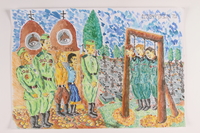
Autobiographical painting of partisans and Soviet soldiers view the hanging of 3 German soldiers
Object
Painting by Arie (Aryeh) Singer depicting himself as a teenaged partisan, observing with Gilda, a fellow partisan, and 3 Soviet soldiers, the hanging of 3 German soldiers in the forest. It is from a series of works detailing events from his youth as a 13 year old partisan fighter in the forests northeast of Vilna, Poland, (Vilnius, Lithuania) and in Belarus from 1943-1944. After the Soviet occupation of Vilna in late 1939, Arie's family fled to Glembokie (Hlybokaye, Belarus). When Germany invaded Russia in June 1941, the area was assaulted by German mobile killing units, who with the help of the local populace, murdered thousands of Jews. Arie and his mother were forced into the Jewish ghetto. His father, Zvi, 38, was killed in the massacres at Ponary in 1941. In spring 1943, Arie and his mother, Chaya, 35, escaped the ghetto, which was being destroyed by the Germans. They went into hiding in the Nievier Forest near Vilna, where they engaged in partisan activities. The area was liberated by the Red Army in July 1944. After some years in a displaced persons camps, Arie and Chaya emigrated to Israel in the late 1940s. Colonel Singer began creating this series of paintings about his Holocaust experiences as rehabilitation following a stroke.

Autobiographical painting of partisans led by young boy meeting soldiers near Kiev
Object
Painting by Arie (Aryeh) Singer depicting himself carrying the flag for a group of partisans meeting with Soviet soldiers in southern Ukraine, near Kiev. It is from a series of works detailing events from his youth as a 13 year old partisan fighter in the forests northeast of Vilna, Poland, (Vilnius, Lithuania) and in Belarus from 1943-1944. After the Soviet occupation of Vilna in late 1939, Arie's family fled to Glembokie (Hlybokaye, Belarus). When Germany invaded Russia in June 1941, the area was assaulted by German mobile killing units, who with the help of the local populace, murdered thousands of Jews. Arie and his mother were forced into the Jewish ghetto. His father, Zvi, age 38, was killed in the massacres at Ponary in 1941. In spring 1943, Arie and his mother, Chaya, 35, escaped the ghetto, which was being destroyed by the Germans. They went into hiding in the Nievier Forest near Vilna, where they engaged in partisan activities. The area was liberated by the Red Army in July 1944. After some years in a displaced persons camps, Arie and Chaya emigrated to Israel in the late 1940s. Colonel Singer began creating this series of paintings about his Holocaust experiences as rehabilitation following a stroke.
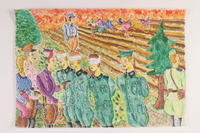
Autobiographical painting of partisans holding German prisoners at gunpoint after battle
Object
Painting by Arie (Aryeh) Singer depicting the line-up of captured German soldiers; in the background are the bodies of partisans, including a medic, sickened by an illness that struck the camp near the end of the war. It is from a series of works detailing events from his youth as a 13 year old partisan fighter in the forests northeast of Vilna, Poland, (Vilnius, Lithuania) and in Belarus from 1943-1944. After the Soviet occupation of Vilna in late 1939, Arie's family fled to Glembokie (Hlybokaye, Belarus). When Germany invaded Russia in June 1941, the area was assaulted by German mobile killing units, who with the help of the local populace, murdered thousands of Jews. Arie and his mother were forced into the Jewish ghetto. His father, Zvi, age 38, was killed in the massacres at Ponary in 1941. In spring 1943, Arie and his mother, Chaya, 35, escaped the ghetto, which was being destroyed by the Germans. They went into hiding in the Nievier Forest near Vilna, where they engaged in partisan activities. The area was liberated by the Red Army in July 1944. After some years in a displaced persons camps, Arie and Chaya emigrated to Israel in the late 1940s. Colonel Singer began creating this series of paintings about his Holocaust experiences following a stroke.

Autobiographical painting of a large group of armed partisans marching in a forest near Vilna
Object
Painting by Arie (Aryeh) Singer depicting a group of armed partisans marching through the forest. It is from a series of works created from 1985-2000 detailing memories of his youth as a 13 year old partisan fighter in the forests northeast of Vilna, Poland, (Vilnius, Lithuania) and in Belarus from 1943-1944. After the Soviet occupation of Vilna in late 1939, Arie's family fled to Glembokie (Hlybokaye, Belarus). When Germany invaded Russia in June 1941, the area was assaulted by German mobile killing units, who with the help of the local populace, murdered thousands of Jews. Arie and his mother were forced into the Jewish ghetto. His father, Zvi, 38, was killed in the massacres at Ponary in 1941. In spring 1943, Arie and his mother, Chaya, 35, escaped the ghetto, which was being destroyed by the Germans. They went into hiding in the Nievier Forest near Vilna, where they engaged in partisan activities. The area was liberated by the Red Army in July 1944. After some years in a displaced persons camps, Arie and Chaya emigrated to Israel in the late 1940s. Colonel Singer began creating this series of paintings about his Holocaust experiences in the mid 1980s as rehabilitation following a stroke.

Autobiographical painting of partisans blowing up a Nazi train in a forest near Vilna
Object
Painting by Arie (Aryeh) Singer depicting partisans blowing up a Nazi train. It is from a series created from 1985-2000 detailing memories and events from his youth as a 13 year old partisan fighter in the forests northeast of Vilna, Poland, (Vilnius, Lithuania) and in Belarus from 1943-1944. After the Soviet occupation of Vilna in late 1939, Arie's family fled to Glembokie (Hlybokaye, Belarus). When Germany invaded Russia in June 1941, the area was assaulted by German mobile killing units, who with the help of the local populace, murdered thousands of Jews. Arie and his mother were forced into the Jewish ghetto. His father, Zvi, 38, was killed in the massacres at Ponary in 1941. In spring 1943, Arie and his mother, Chaya, 35, escaped the ghetto, which was being destroyed by the Germans. They went into hiding in the Nievier Forest near Vilna, where they engaged in partisan activities. The area was liberated by the Red Army in July 1944. After some years in a displaced persons camps, Arie and Chaya emigrated to Israel in the late 1940s. Colonel Singer began creating this series of paintings about his Holocaust experiences in the mid 1980s as rehabilitation following a stroke in 1975.

Autobiographical painting of partisans approaching train tracks near Lokda
Object
Painting by Arie (Aryeh) Singer depicting himself with a group of partisans near Lokda. It is from a series created from 1985-2000 detailing memories and events from his youth as a 13 year old partisan fighter in the forests northeast of Vilna, Poland, (Vilnius, Lithuania) and in Belarus from 1943-1944. After the Soviet occupation of Vilna in late 1939, Arie's family fled to Glembokie (Hlybokaye, Belarus). When Germany invaded Russia in June 1941, the area was assaulted by German mobile killing units, who with the help of the local populace, murdered thousands of Jews. Arie and his mother were forced into the Jewish ghetto. His father, Zvi, 38, was killed in the massacres at Ponary in 1941. In sprng 1943, Arie and his mother, Chaya, 35, escaped the ghetto, which was being destroyed by the Germans. They went into hiding in the Nievier Forest near Vilna, where they engaged in partisan activities. The area was liberated by the Red Army in July 1944. After some years in a displaced persons camps, Arie and Chaya emigrated to Israel in the late 1940s. Colonel Singer began creating this series of paintings about his Holocaust experiences in the mid 1980s as rehabilitation following a stroke.

Autobiographical painting of partisans shooting and killing a group of Nazi soldiers
Object
Painting by Arie (Aryeh) Singer depicting a group of partisans in a gun battle across a tilled field against a group of German soldiers. It is from a series created from 1985-2000 detailing memories and events from his youth as a 13 year old partisan fighter in the forests northeast of Vilna, Poland, (Vilnius, Lithuania) and in Belarus from 1943-1944. After the Soviet occupation of Vilna in late 1939, Arie's family fled to Glembokie (Hlybokaye, Belarus). When Germany invaded Russia in June 1941, the area was assaulted by German mobile killing units, who with the help of the local populace, murdered thousands of Jews. Arie and his mother were forced into the Jewish ghetto. His father, Zvi, 38, was killed in the massacres at Ponary in 1941. In spring 1943, Arie and his mother, Chaya, age 35, escaped the ghetto, which was being destroyed by the Germans. They went into hiding in the Nievier Forest near Vilna, where they engaged in partisan activities. The area was liberated by the Red Army in July 1944. After some years in a displaced persons camps, Arie and Chaya emigrated to Israel in the late 1940s. Colonel Singer began creating this series of paintings about his Holocaust experiences in the mid 1980s as rehabilitation following a stroke in 1975.

Autobiographical painting of partisans shooting 2 German soldiers
Object
Painting by Arie (Aryeh) Singer depicting 2 partisans, within the forest, shooting 2 German soldiers. It is from a series created from 1985-2000 detailing memories and events from his youth as a 13 year old partisan fighter in the forests northeast of Vilna, Poland, (Vilnius, Lithuania) and in Belarus from 1943-1944. After the Soviet occupation of Vilna in late 1939, Arie's family fled to Glembokie (Hlybokaye, Belarus). When Germany invaded Russia in June 1941, the area was assaulted by German mobile killing units, who with the help of the local populace, murdered thousands of Jews. Arie and his mother were forced into the Jewish ghetto. His father, Zvi, 38, was killed in the massacres at Ponary in 1941. In spring 1943, Arie and his mother, Chaya, 35, escaped the ghetto, which was being destroyed by the Germans. They went into hiding in the Nievier Forest near Vilna, where they engaged in partisan activities. The area was liberated by the Red Army in July 1944. After some years in a displaced persons camps, Arie and Chaya emigrated to Israel in the late 1940s. Colonel Singer began creating this series of paintings about his Holocaust experiences in the mid 1980s as rehabilitation following a stroke in 1975.

Autobiographical painting of partisans running past 2 dead German soldiers
Object
Painting by Arie (Aryeh) Singer depicting 2 partisans running into the forest, past 2 dead German soldiers. It is from a series created from 1985-2000 based upon memories and events from his youth as a 13 year old partisan fighter in the forests northeast of Vilna, Poland, (Vilnius, Lithuania) and in Belarus from 1943-1944. After the Soviet occupation of Vilna in late 1939, Arie's family fled to Glembokie (Hlybokaye, Belarus). When Germany invaded Russia in June 1941, the area was assaulted by German mobile killing units, who with the help of the local populace, murdered thousands of Jews. Arie and his mother were forced into the Jewish ghetto. His father, Zvi, age 38, was killed in the massacres at Ponary in 1941. As the pogroms continued into the spring of 1943, Arie and his mother, Chaya, age 35, escaped the ghetto, which was being destroyed by the Germans. They went into hiding in the Nievier Forest near Vilna, where they engaged in partisan activities. The area was liberated by the Red Army in July 1944. After some years in a displaced persons camps, Arie and Chaya emigrated to Israel in the late 1940s. Colonel Singer began creating this series of paintings about his Holocaust experiences in the mid 1980s as rehabilitation following a stroke in 1975.

Painting of a young boy protecting people with Judenstern from German soldiers
Object
Painting by Arie (Aryeh) Singer depicting a wishful fantasy of a young boy saving Jewish villagers from soldiers wearing Nazi insignia in the Glembokie ghetto. It is from a series created from 1985-2000 based upon memories and events from his youth as a 13 year old partisan fighter in the forests northeast of Vilna, Poland, (Vilnius, Lithuania) and in Belarus from 1943-1944. After the Soviet occupation of Vilna in late 1939, Arie's family fled to Glembokie (Hlybokaye, Belarus). When Germany invaded Russia in June 1941, the area was assaulted by German mobile killing units, who with the help of the local populace, murdered thousands of Jews. Arie and his mother were forced into the Jewish ghetto. His father, Zvi, age 38, was killed in the massacres at Ponary in 1941. As the pogroms continued into the spring of 1943, Arie and his mother, Chaya, age 35, escaped the ghetto, which was being destroyed by the Germans. They went into hiding in the Nievier Forest near Vilna, where they engaged in partisan activities. The area was liberated by the Red Army in July 1944. After some years in a displaced persons camps, Arie and Chaya emigrated to Israel in the late 1940s. Colonel Singer began creating this series of paintings about his Holocaust experiences in the mid 1980s as rehabilitation following a stroke in 1975.
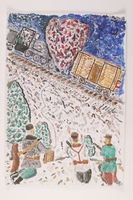
Watercolor of partisans setting off an explosion to stop a swastika marked train
Object
Painting by Arie (Aryeh) Singer depicting a group of partisans detonating an explosion in the path of a German train. It is from a series created from 1985-2000 based upon memories and events from his youth as a 13 year old partisan fighter in the forests northeast of Vilna, Poland, (Vilnius, Lithuania) and in Belarus from 1943-1944. After the Soviet occupation of Vilna in late 1939, Arie's family fled to Glembokie (Hlybokaye, Belarus). When Germany invaded Russia in June 1941, the area was assaulted by German mobile killing units, who with the help of the local populace, murdered thousands of Jews. Arie and his mother were forced into the Jewish ghetto. His father, Zvi, age 38, was killed in the massacres at Ponary in 1941. In spring 1943, Arie and his mother, Chaya, 35, escaped the ghetto, which was being destroyed by the Germans. They went into hiding in the Nievier Forest near Vilna, where they engaged in partisan activities. The area was liberated by the Red Army in July 1944. After some years in a displaced persons camps, Arie and Chaya emigrated to Israel in the late 1940s. Colonel Singer began creating this series of paintings about his Holocaust experiences in the mid 1980s as rehabilitation following a stroke in 1975.
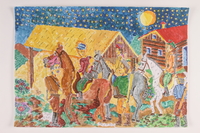
Autobiographical painting of a group of partisans preparing to leave for night patrol
Object
Painting by Arie (Aryeh) Singer depicting a group of partisans getting ready to go out on night patrol. It is from a series created from 1985-2000 based upon memories and events from his youth as a 13 year old partisan fighter in the forests northeast of Vilna, Poland, (Vilnius, Lithuania) and in Belarus from 1943-1944. After the Soviet occupation of Vilna in late 1939, Arie's family fled to Glembokie (Hlybokaye, Belarus). When Germany invaded Russia in June 1941, the area was assaulted by German mobile killing units, who with the help of the local populace, murdered thousands of Jews. Arie and his mother were forced into the Jewish ghetto. His father, Zvi, age 38, was killed in the massacres at Ponary in 1941. As the pogroms continued into the spring of 1943, Arie and his mother, Chaya, age 35, escaped the ghetto, which was being destroyed by the Germans. They went into hiding in the Nievier Forest near Vilna, where they engaged in partisan activities. The area was liberated by the Red Army in July 1944. After some years in a displaced persons camps, Arie and Chaya emigrated to Israel in the late 1940s. Colonel Singer began creating this series of paintings about his Holocaust experiences in the mid 1980s as rehabilitation following a stroke in 1975.
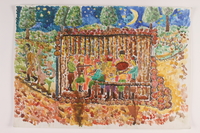
Autobiographical painting of partisans at rest in an underground cabin in a forest
Object
Painting by Arie (Aryeh) Singer depicting a group of partisans eating and cleaning rifles inside their underground cabin in the forest. It is from a series created from 1985-2000 based upon memories and events from his youth as a 13 year old partisan fighter in the forests northeast of Vilna, Poland, (Vilnius, Lithuania) and in Belarus from 1943-1944. After the Soviet occupation of Vilna in late 1939, Arie's family fled to Glembokie (Hlybokaye, Belarus). When Germany invaded Russia in June 1941, the area was assaulted by German mobile killing units, who with the help of the local populace, murdered thousands of Jews. Arie and his mother were forced into the Jewish ghetto. His father, Zvi, age 38, was killed in the massacres at Ponary in 1941. As the pogroms continued into the spring of 1943, Arie and his mother, Chaya, age 35, escaped the ghetto, which was being destroyed by the Germans. They went into hiding in the Nievier Forest near Vilna, where they engaged in partisan activities. The area was liberated by the Red Army in July 1944. After some years in a displaced persons camps, Arie and Chaya emigrated to Israel in the late 1940s. Colonel Singer began creating this series of paintings about his Holocaust experiences in the mid 1980s as rehabilitation following a stroke in 1975.
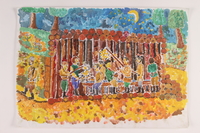
Painting of partisans sharing a meal inside their shelter in the forest
Object
Painting by Arie (Aryeh) Singer depicting a group of partisans sharing a meal inside their forest hideout. It is from a series created from 1985-2000 based upon memories and events from his youth as a 13 year old partisan fighter in the forests northeast of Vilna, Poland, (Vilnius, Lithuania) and in Belarus from 1943-1944. After the Soviet occupation of Vilna in late 1939, Arie's family fled to Glembokie (Hlybokaye, Belarus). When Germany invaded Russia in June 1941, the area was assaulted by German mobile killing units, who with the help of the local populace, murdered thousands of Jews. Arie and his mother were forced into the Jewish ghetto. His father, Zvi, age 38, was killed in the massacres at Ponary in 1941. As the pogroms continued into the spring of 1943, Arie and his mother, Chaya, age 35, escaped the ghetto, which was being destroyed by the Germans. They went into hiding in the Nievier Forest near Vilna, where they engaged in partisan activities. The area was liberated by the Red Army in July 1944. After some years in a displaced persons camps, Arie and Chaya emigrated to Israel in the late 1940s. Colonel Singer began creating this series of paintings about his Holocaust experiences in the mid 1980s as rehabilitation following a stroke in 1975.
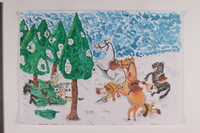
Autobiographical painting of German soldiers attacking in the snow
Object
Painting by Arie (Aryeh) Singer depicting 3 German soldiers firing on 3 possibly partisans or Soviet soldiers in the snow. It is from a series created from 1985-2000 based upon memories and events from his youth as a 13 year old partisan fighter in the forests northeast of Vilna, Poland, (Vilnius, Lithuania) and in Belarus from 1943-1944. After the Soviet occupation of Vilna in late 1939, Arie's family fled to Glembokie (Hlybokaye, Belarus). When Germany invaded Russia in June 1941, the area was assaulted by German mobile killing units, who with the help of the local populace, murdered thousands of Jews. Arie and his mother were forced into the Jewish ghetto. His father, Zvi, age 38, was killed in the massacres at Ponary in 1941. As the pogroms continued into the spring of 1943, Arie and his mother, Chaya, age 35, escaped the ghetto, which was being destroyed by the Germans. They went into hiding in the Nievier Forest near Vilna, where they engaged in partisan activities. The area was liberated by the Red Army in July 1944. After some years in a displaced persons camps, Arie and Chaya emigrated to Israel in the late 1940s. Colonel Singer began creating this series of paintings about his Holocaust experiences in the mid 1980s as rehabilitation following a stroke in 1975.
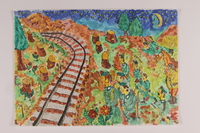
Autobiographical watercolor of German soldiers moving toward train tracks at night
Object
Painting by Arie (Aryeh) Singer depicting a platoon of German soldiers advancing on rail tracks within the forest. It is from a series created from 1985-2000 based upon memories and events from his youth as a 13 year old partisan fighter in the forests northeast of Vilna, Poland, (Vilnius, Lithuania) and in Belarus from 1943-1944. After the Soviet occupation of Vilna in late 1939, Arie's family fled to Glembokie (Hlybokaye, Belarus). When Germany invaded Russia in June 1941, the area was assaulted by German mobile killing units, who with the help of the local populace, murdered thousands of Jews. Arie and his mother were forced into the Jewish ghetto. His father, Zvi, age 38, was killed in the massacres at Ponary in 1941. As the pogroms continued into the spring of 1943, Arie and his mother, Chaya, age 35, escaped the ghetto, which was being destroyed by the Germans. They went into hiding in the Nievier Forest near Vilna, where they engaged in partisan activities. The area was liberated by the Red Army in July 1944. After some years in a displaced persons camps, Arie and Chaya emigrated to Israel in the late 1940s. Colonel Singer began creating this series of paintings about his Holocaust experiences in the mid 1980s as rehabilitation following a stroke in 1975.

Autobiographical painting of a partisan on horseback leading soldiers on a march through the forest
Object
Painting by Arie (Aryeh) Singer depicting a mixed group of partisans and soldiers, possibly Soviet, walking through the forest. It is from a series created from 1985-2000 based upon memories and events from his youth as a 13 year old partisan fighter in the forests northeast of Vilna, Poland, (Vilnius, Lithuania) and in Belarus from 1943-1944. After the Soviet occupation of Vilna in late 1939, Arie's family fled to Glembokie (Hlybokaye, Belarus). When Germany invaded Russia in June 1941, the area was assaulted by German mobile killing units, who with the help of the local populace, murdered thousands of Jews. Arie and his mother were forced into the Jewish ghetto. His father, Zvi, age 38, was killed in the massacres at Ponary in 1941. As the pogroms continued into the spring of 1943, Arie and his mother, Chaya, age 35, escaped the ghetto, which was being destroyed by the Germans. They went into hiding in the Nievier Forest near Vilna, where they engaged in partisan activities. The area was liberated by the Red Army in July 1944. After some years in a displaced persons camps, Arie and Chaya emigrated to Israel in the late 1940s. Colonel Singer began creating this series of paintings about his Holocaust experiences in the mid 1980s as rehabilitation following a stroke in 1975.
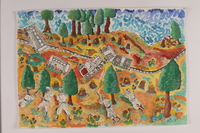
Painting of a group of partisans preparing to attack a derailed train marked with swastikas
Object
Painting by Arie (Aryeh) Singer depicting 5 soldiers hidden in the trees with rifles aimed at a derailed German train. It is from a series created from 1985-2000 based upon memories and events from his youth as a 13 year old partisan fighter in the forests northeast of Vilna, Poland, (Vilnius, Lithuania) and in Belarus from 1943-1944. After the Soviet occupation of Vilna in late 1939, Arie's family fled to Glembokie (Hlybokaye, Belarus). When Germany invaded Russia in June 1941, the area was assaulted by German mobile killing units, who with the help of the local populace, murdered thousands of Jews. Arie and his mother were forced into the Jewish ghetto. His father, Zvi, age 38, was killed in the massacres at Ponary in 1941. As the pogroms continued into the spring of 1943, Arie and his mother, Chaya, age 35, escaped the ghetto, which was being destroyed by the Germans. They went into hiding in the Nievier Forest near Vilna, where they engaged in partisan activities. The area was liberated by the Red Army in July 1944. After some years in a displaced persons camps, Arie and Chaya emigrated to Israel in the late 1940s. Colonel Singer began creating this series of paintings about his Holocaust experiences in the mid 1980s as rehabilitation following a stroke in 1975.

Autobiographical watercolor of a partisan patrol removing train rails
Object
Painting by Arie (Aryeh) Singer depicting 2 armed partisans on guard for a group of 6 at work dismantling a railroad track near tilled fields in a forest clearing. It is from a series created from 1985-2000 based upon memories and events from his youth as a 13 year old partisan fighter in the forests northeast of Vilna, Poland, (Vilnius, Lithuania) and in Belarus from 1943-1944. After the Soviet occupation of Vilna in late 1939, Arie's family fled to Glembokie (Hlybokaye, Belarus). When Germany invaded Russia in June 1941, the area was assaulted by German mobile killing units, who with the help of the local populace, murdered thousands of Jews. Arie and his mother were forced into the Jewish ghetto. His father, Zvi, age 38, was killed in the massacres at Ponary in 1941. As the pogroms continued into the spring of 1943, Arie and his mother, Chaya, age 35, escaped the ghetto, which was being destroyed by the Germans. They went into hiding in the Nievier Forest near Vilna, where they engaged in partisan activities. The area was liberated by the Red Army in July 1944. After some years in a displaced persons camps, Arie and Chaya emigrated to Israel in the late 1940s. Colonel Singer began creating this series of paintings about his Holocaust experiences in the mid 1980s as rehabilitation following a stroke in 1975.
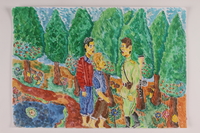
Autobiographical watercolor featuring two youthful partisans meeting with a uniformed soldier
Object
Painting by Arie (Aryeh) Singer depicting himself and a friend meeting a uniformed Russian soldier in the forest. It is from a series created from 1985-2000 based upon memories and events from his youth as a 13 year old partisan fighter in the forests northeast of Vilna, Poland, (Vilnius, Lithuania) and in Belarus from 1943-1944. After the Soviet occupation of Vilna in late 1939, Arie's family fled to Glembokie (Hlybokaye, Belarus). When Germany invaded Russia in June 1941, the area was assaulted by German mobile killing units, who with the help of the local populace, murdered thousands of Jews. Arie and his mother were forced into the Jewish ghetto. His father, Zvi, age 38, was killed in the massacres at Ponary in 1941. As the pogroms continued into the spring of 1943, Arie and his mother, Chaya, age 35, escaped the ghetto, which was being destroyed by the Germans. They went into hiding in the Nievier Forest near Vilna, where they engaged in partisan activities. The area was liberated by the Red Army in July 1944. After some years in a displaced persons camps, Arie and Chaya emigrated to Israel in the late 1940s. Colonel Singer began creating this series of paintings about his Holocaust experiences in the mid 1980s as rehabilitation following a stroke in 1975.

Autobiographical painting of armed partisans resting in a tilled field
Object
Painting by Arie (Aryeh) Singer depicting 6 heavily armed partisans, 5 men and 1 woman, in colorful civilian clothing sitting with their backs against three large bushy trees in a tilled field. It is from a series created from 1985-2000 based upon memories and events from his youth as a 13 year old partisan fighter in the forests northeast of Vilna, Poland, (Vilnius, Lithuania) and in Belarus from 1943-1944. After the Soviet occupation of Vilna in late 1939, Arie's family fled to Glembokie (Hlybokaye, Belarus). When Germany invaded Russia in June 1941, the area was assaulted by German mobile killing units, who with the help of the local populace, murdered thousands of Jews. Arie and his mother were forced into the Jewish ghetto. His father, Zvi, age 38, was killed in the massacres at Ponary in 1941. As the pogroms continued into the spring of 1943, Arie and his mother, Chaya, age 35, escaped the ghetto, which was being destroyed by the Germans. They went into hiding in the Nievier Forest near Vilna, where they engaged in partisan activities. The area was liberated by the Red Army in July 1944. After some years in a displaced persons camps, Arie and Chaya emigrated to Israel in the late 1940s. Colonel Singer began creating this series of paintings about his Holocaust experiences in the mid 1980s as rehabilitation following a stroke in 1975.

Imagined scene of inmates playing violins as Jews are sorted by German guards at a concentration camp
Object
Detailed colored drawing by Arie Singer depicting an imagined scene a group of men, women, and children with backpacks and wearing yellow Stars of David walking across a yard and being sorted into lines by green uniformed Nazi soldiers. Three people in striped uniforms hold violins in the upper left and 3 people enter a wooden building on the right. After the Soviet occupation of Vilna, Poland (Vilnius, Lithuania), in late 1939, nine year old Arie and his family fled to Glembokie (Hlybokaye, Belarus). When Germany invaded Russia in June 1941, the area was assaulted by German mobile killing units, who with the help of the local populace, murdered thousands of Jews. Arie and his mother were forced into the Jewish ghetto. His father, Zvi, age 38, was killed in the massacres at Ponary in 1941. As the pogroms continued into the spring of 1943, Arie and his mother, Chaya, age 35, escaped the ghetto, which was being destroyed by the Germans. They went into hiding in the Nievier Forest near Vilna, where they engaged in partisan activities. The area was liberated by the Red Army in July 1944. After some years in a displaced persons camps, Arie and Chaya emigrated to Israel in the late 1940s. Colonel Singer began creating this series of paintings about his Holocaust experiences in the mid 1980s as rehabilitation following a stroke in 1975.

Colored pencil drawing of the final red train cars passing through a concentration camp gate
Object
Colored drawing done by around 1990 by Arie Singer commemorating the millions of Jews who were murdered in Auschwitz concentration camp. It depicts a line of red cattle cars entering the gate of a concentration camp as 2 German soldiers watch; there is a pencil sketch on the reverse. After the Soviet occupation of Vilna, Poland (Vilnius, Lithuania), in late 1939, nine year old Arie and his family fled to Glembokie (Hlybokaye, Belarus). When Germany invaded Russia in June 1941, the area was assaulted by German mobile killing units, who with the help of the local populace, murdered thousands of Jews. Arie and his mother were forced into the Jewish ghetto. His father, Zvi, age 38, was killed in the massacres at Ponary in 1941. As the pogroms continued into the spring of 1943, Arie and his mother, Chaya, age 35, escaped the ghetto, which was being destroyed by the Germans. They went into hiding in the Nievier (sic) Forest near Vilna, where they engaged in partisan activities. The area was liberated by the Red Army in July 1944. After some years in a displaced persons camps, Arie and Chaya emigrated to Israel in the late 1940s. Colonel Singer began creating this series of paintings about his Holocaust experiences in the mid 1980s as rehabilitation following a stroke in 1975.

Autobiographical painting of a Jewish family protecting three flower beds from snow in the ghetto
Object
Watercolor and marker drawing by Arie (Aryeh) Singer depicting himself as a young boy, with a woman and a man in winter coats and hats with yellow Star of David badges taking care of flower beds near the hothouses in the Glembokie, Poland (Hlybokaye (Belarus) ghetto in March 1942. It is from a series created from 1985-2000 based upon memories and events from his youth as a 13 year old partisan fighter in the forests northeast of Vilna, Poland, (Vilnius, Lithuania) and in Belarus from 1943-1944. After the Soviet occupation of Vilna in late 1939, Arie's family fled to Glembokie (Hlybokaye, Belarus). When Germany invaded Russia in June 1941, the area was assaulted by German mobile killing units, who with the help of the local populace, murdered thousands of Jews. Arie and his mother were forced into the Jewish ghetto. His father, Zvi, age 38, was killed in the massacres at Ponary in 1941. As the pogroms continued into the spring of 1943, Arie and his mother, Chaya, age 35, escaped the ghetto, which was being destroyed by the Germans. They went into hiding in the Nievier Forest near Vilna, where they engaged in partisan activities. The area was liberated by the Red Army in July 1944. After some years in a displaced persons camps, Arie and Chaya emigrated to Israel in the late 1940s. Colonel Singer began creating this series of paintings about his Holocaust experiences in the mid 1980s as rehabilitation following a stroke in 1975.
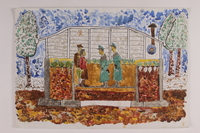
Autobiographical watercolor of an encounter between a Jewish couple and German guards
Object
Watercolor painting by Arie (Aryeh) Singer depicting a man and women with Star of David badges being confronted by two German guards inside a vegetable hothouse in the ghetto in Glembokie, Poland (Hlybokaye (Belarus). It is from a series created from 1985-2000 based upon memories and events from his youth as a 13 year old partisan fighter in the forests northeast of Vilna, Poland, (Vilnius, Lithuania) and in Belarus from 1943-1944. After the Soviet occupation of Vilna in late 1939, Arie's family fled to Glembokie. When Germany invaded Russia in June 1941, the area was assaulted by German mobile killing units, who with the help of the local populace, murdered thousands of Jews. Arie and his mother were forced into the Jewish ghetto. His father, Zvi, age 38, was killed in the massacres at Ponary in 1941. As the pogroms continued into the spring of 1943, Arie and his mother, Chaya, age 35, escaped the ghetto, which was being destroyed by the Germans. They went into hiding in the Nievier Forest near Vilna, where they engaged in partisan activities. The area was liberated by the Red Army in July 1944. After some years in a displaced persons camps, Arie and Chaya emigrated to Israel in the late 1940s. Colonel Singer began creating this series of paintings about his Holocaust experiences in the mid 1980s as rehabilitation following a stroke in 1975.
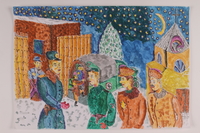
Autobiographical watercolor of Jews being unloaded from a truck by German and Lithuanian soldiers
Object
Painting by Arie (Aryeh) Singer depicting the night of December 20, 1941, when he and his family were deported to the Glembokie ghetto. It shows him as a young boy getting out of a truck in front of a gated entrance as German and Lithuanian soldiers and Jewish men talk in the foreground. It is from a series created from 1985-2000 based upon memories and events from his youth as a 13 year old partisan fighter in the forests northeast of Vilna, Poland, (Vilnius, Lithuania) and in Belarus from 1943-1944. After the Soviet occupation of Vilna in late 1939, Arie's family fled to Glembokie (Hlybokaye, Belarus). When Germany invaded Russia in June 1941, the area was assaulted by German mobile killing units, who with the help of the local populace, murdered thousands of Jews. Arie and his mother were forced into the Jewish ghetto. His father, Zvi, age 38, was killed in the massacres at Ponary in 1941. As the pogroms continued into the spring of 1943, Arie and his mother, Chaya, age 35, escaped the ghetto, which was being destroyed by the Germans. They went into hiding in the Nievier Forest near Vilna, where they engaged in partisan activities. The area was liberated by the Red Army in July 1944. After some years in a displaced persons camps, Arie and Chaya emigrated to Israel in the late 1940s. Colonel Singer began creating this series of paintings about his Holocaust experiences in the mid 1980s as rehabilitation following a stroke in 1975.

Autobiographical drawing of a Jewish family at a ghetto gate ID checkpoint
Object
Watercolor by Arie (Aryeh) Singer depicting himself as a young boy with his parents begni inspected by soldiers at a Glembokie ghetto checkpoint. It is from a series created from 1985-2000 based upon memories and events from his youth as a 13 year old partisan fighter in the forests northeast of Vilna, Poland, (Vilnius, Lithuania) and in Belarus from 1943-1944. After the Soviet occupation of Vilna in late 1939, Arie's family fled to Glembokie (Hlybokaye, Belarus). When Germany invaded Russia in June 1941, the area was assaulted by German mobile killing units, who with the help of the local populace, murdered thousands of Jews. Arie and his mother were forced into the Jewish ghetto. His father, Zvi, age 38, was killed in the massacres at Ponary in 1941. As the pogroms continued into the spring of 1943, Arie and his mother, Chaya, age 35, escaped the ghetto, which was being destroyed by the Germans. They went into hiding in the Nievier Forest near Vilna, where they engaged in partisan activities. The area was liberated by the Red Army in July 1944. After some years in a displaced persons camps, Arie and Chaya emigrated to Israel in the late 1940s. Colonel Singer began creating this series of paintings about his Holocaust experiences in the mid 1980s as rehabilitation following a stroke in 1975.
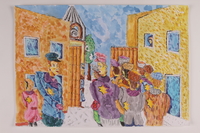
Autobiographical drawing of Jewish workers lined up to leave the ghetto
Object
Mixed media painting created by Arie Singer depicting life in the ghetto in Glembokie (Hlybokaye), Belarus, from 1941-1943. This image shows 2 lines of people with Stars of David on their backs waiting to go through the wooden gate to their forced labor assignments. This is part of a series of works about daily life in the Glembokie ghetto. It is from a series created from 1985-2000 based upon memories and events from his youth as a 13 year old partisan fighter in the forests northeast of Vilna, Poland, (Vilnius, Lithuania) and in Belarus from 1943-1944. After the Soviet occupation of Vilna in late 1939, Arie's family fled to Glembokie (Hlybokaye, Belarus). When Germany invaded Russia in June 1941, the area was assaulted by German mobile killing units, who with the help of the local populace, murdered thousands of Jews. Arie and his mother were forced into the Jewish ghetto. His father, Zvi, age 38, was killed in the massacres at Ponary in 1941. As the pogroms continued into the spring of 1943, Arie and his mother, Chaya, age 35, escaped the ghetto, which was being destroyed by the Germans. They went into hiding in the Nievier Forest near Vilna, where they engaged in partisan activities. The area was liberated by the Red Army in July 1944. After some years in a displaced persons camps, Arie and Chaya emigrated to Israel in the late 1940s. Colonel Singer began creating this series of paintings about his Holocaust experiences in the mid 1980s as rehabilitation following a stroke in 1975.

Autobiographical watercolor of a group of Jews and soldiers at a ghetto checkpoint
Object
Watercolor drawing by Arie (Aryeh) Singer depicting the night he and his family entered the ghetto in Glembokie, Poland (Hlybokaye, Belarus), Aryeh is the young boy in a yellow coat standing near the front of a line of people with Star of David badges waiting to go through a ghetto checkpoint. It is from a series created from 1985-2000 based upon memories and events from his youth as a 13 year old partisan fighter in the forests northeast of Vilna, Poland, (Vilnius, Lithuania) and in Belarus from 1943-1944. After the Soviet occupation of Vilna in late 1939, Arie's family fled to Glembokie (Hlybokaye, Belarus). When Germany invaded Russia in June 1941, the area was assaulted by German mobile killing units, who with the help of the local populace, murdered thousands of Jews. Arie and his mother were forced into the Jewish ghetto. His father, Zvi, age 38, was killed in the massacres at Ponary in 1941. As the pogroms continued into the spring of 1943, Arie and his mother, Chaya, age 35, escaped the ghetto, which was being destroyed by the Germans. They went into hiding in the Nievier Forest near Vilna, where they engaged in partisan activities. The area was liberated by the Red Army in July 1944. After some years in a displaced persons camps, Arie and Chaya emigrated to Israel in the late 1940s. Colonel Singer began creating this series of paintings about his Holocaust experiences in the mid 1980s as rehabilitation following a stroke in 1975.
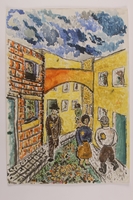
Autobiographical watercolor of people with Star of David badges walking on a city street
Object
Street scene of people with Star of David parches walking down the street. It is from a series created from 1985-2000 based upon memories and events from his youth as a 13 year old partisan fighter in the forests northeast of Vilna, Poland, (Vilnius, Lithuania) and in Belarus from 1943-1944. After the Soviet occupation of Vilna in late 1939, Arie's family fled to Glembokie (Hlybokaye, Belarus). When Germany invaded Russia in June 1941, the area was assaulted by German mobile killing units, who with the help of the local populace, murdered thousands of Jews. Arie and his mother were forced into the Jewish ghetto. His father, Zvi, age 38, was killed in the massacres at Ponary in 1941. As the pogroms continued into the spring of 1943, Arie and his mother, Chaya, age 35, escaped the ghetto, which was being destroyed by the Germans. They went into hiding in the Nievier Forest near Vilna, where they engaged in partisan activities. The area was liberated by the Red Army in July 1944. After some years in a displaced persons camps, Arie and Chaya emigrated to Israel in the late 1940s. Colonel Singer began creating this series of paintings about his Holocaust experiences in the mid 1980s as rehabilitation following a stroke in 1975.
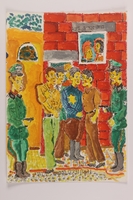
Autobiographical painting of a boy watching Nazi soldiers detaining a group of Jewish men at gunpoint
Object
Mixed media painting created by Arie Singer memorializing the day, July 17, 1941, that his father, Zvi, was taken and shot in the Ponary forest. It depicts Arie’s father, Zvi, standing with a group of men wearing Star of David badges in front of a red brick building with soldiers pointing pistols at them. Arie and his mother can be seen at a window; the Singer family lived in the red brick building next to a synagogue. It is from a series created from 1985-2000 based upon memories and events from his youth as a 13 year old partisan fighter in the forests northeast of Vilna, Poland, (Vilnius, Lithuania) and in Belarus from 1943-1944. After the Soviet occupation of Vilna in late 1939, Arie's family fled to Glembokie (Hlybokaye, Belarus). When Germany invaded Russia in June 1941, the area was assaulted by German mobile killing units, who with the help of the local populace, murdered thousands of Jews. Arie and his mother were forced into the Jewish ghetto. His father, Zvi, age 38, was killed in the massacres at Ponary in 1941. As the pogroms continued into the spring of 1943, Arie and his mother, Chaya, age 35, escaped the ghetto, which was being destroyed by the Germans. They went into hiding in the Nievier Forest near Vilna, where they engaged in partisan activities. The area was liberated by the Red Army in July 1944. After some years in a displaced persons camps, Arie and Chaya emigrated to Israel in the late 1940s. Colonel Singer began creating this series of paintings about his Holocaust experiences in the mid 1980s as rehabilitation following a stroke in 1975.

Painting of the cross-section of a 3 story building filled with boys and men with Star of David badges
Object
Painting by Arie Singer representing the overcrowded conditions in the ghetto by showing the cross-section of a three story building with all the rooms filled with Jewish men and boys. It is from a series created from 1985-2000 based upon memories and events from his youth as a 13 year old partisan fighter in the forests northeast of Vilna, Poland, (Vilnius, Lithuania) and in Belarus from 1943-1944. After the Soviet occupation of Vilna in late 1939, Arie's family fled to Glembokie (Hlybokaye, Belarus). When Germany invaded Russia in June 1941, the area was assaulted by German mobile killing units, who with the help of the local populace, murdered thousands of Jews. Arie and his mother were forced into the Jewish ghetto. His father, Zvi, age 38, was killed in the massacres at Ponary in 1941. As the pogroms continued into the spring of 1943, Arie and his mother, Chaya, age 35, escaped the ghetto, which was being destroyed by the Germans. They went into hiding in the Nievier Forest near Vilna, where they engaged in partisan activities. The area was liberated by the Red Army in July 1944. After some years in a displaced persons camps, Arie and Chaya emigrated to Israel in the late 1940s. Colonel Singer began creating this series of paintings about his Holocaust experiences in the mid 1980s as rehabilitation following a stroke in 1975.

Autobiographical painting of a large group of Jews being escorted by guards past a church
Object
Mixed media painting created by Arie Singer. It depicts a large group of men, women, and children wearing Star of David badges flanked by armed Lithuanian guards marching past a large, golden pillared church with a wide staircase. It is from a series created from 1985-2000 based upon memories and events from his youth in the Glembokie ghetto and with the partisans in the forests northeast of Vilna, Poland, (Vilnius, Lithuania) and in Belarus from 1943-1944. After the Soviet occupation of Vilna in late 1939, nine year old Arie and his family fled to Glembokie (Hlybokaye, Belarus). When Germany invaded Russia in June 1941, the area was assaulted by German mobile killing units, who with the help of the local populace, murdered thousands of Jews. Arie and his mother were forced into the Jewish ghetto. His father, Zvi, age 38, was killed in the massacres at Ponary in 1941. As the pogroms continued into the spring of 1943, Arie and his mother, Chaya, age 35, escaped the ghetto, which was being destroyed by the Germans. They went into hiding in the Nievier Forest near Vilna, where they engaged in partisan activities. The area was liberated by the Red Army in July 1944. After some years in a displaced persons camps, Arie and Chaya emigrated to Israel in the late 1940s. Colonel Singer began creating this series of paintings about his Holocaust experiences in the mid 1980s as rehabilitation following a stroke in 1975.
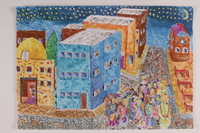
Autobiographical painting of a group of Jewish children, men, and women escorted by guards
Object
Mixed media painting by Arie (Aryeh) Singer depicting a group of Jews, many with backpacks, being escorted by guards down a cobblestoned street; they are at an intersection and behind them on each side is a synagogue. It is from a series created from 1985-2000 based upon memories and events from his youth as a 13 year old partisan fighter in the forests northeast of Vilna, Poland, (Vilnius, Lithuania) and in Belarus from 1943-1944. After the Soviet occupation of Vilna in late 1939, Arie's family fled to Glembokie (Hlybokaye, Belarus). When Germany invaded Russia in June 1941, the area was assaulted by German mobile killing units, who with the help of the local populace, murdered thousands of Jews. Arie and his mother were forced into the Jewish ghetto. His father, Zvi, age 38, was killed in the massacres at Ponary in 1941. As the pogroms continued into the spring of 1943, Arie and his mother, Chaya, age 35, escaped the ghetto, which was being destroyed by the Germans. They went into hiding in the Nievier Forest near Vilna, where they engaged in partisan activities. The area was liberated by the Red Army in July 1944. After some years in a displaced persons camps, Arie and Chaya emigrated to Israel in the late 1940s. Colonel Singer began creating this series of paintings about his Holocaust experiences in the mid 1980s as rehabilitation following a stroke in 1975.

Watercolor painting showing a group of Jewish men, women, and children entering a ghetto
Object
Painting by Arie Singer depicting a group of Jews sent back from prison to the Vilna ghetto. It is from a series created from 1985-2000 based upon memories and events from his youth in Vilna and the Glembokie ghettos in Poland and with the partisans in the forests northeast of Vilna, Poland, (Vilnius, Lithuania) and in Belarus from 1943-1944. After the Soviet occupation of Vilna in late 1939, nine year old Arie and his family fled to Glembokie (Hlybokaye, Belarus). When Germany invaded Russia in June 1941, the area was assaulted by German mobile killing units, who with the help of the local populace, murdered thousands of Jews. Arie and his mother were forced into the Jewish ghetto. His father, Zvi, age 38, was killed in the massacres at Ponary in 1941. As the pogroms continued into the spring of 1943, Arie and his mother, Chaya, age 35, escaped the ghetto, which was being destroyed by the Germans. They went into hiding in the Nievier Forest near Vilna, where they engaged in partisan activities. The area was liberated by the Red Army in July 1944. After some years in a displaced persons camps, Arie and Chaya emigrated to Israel in the late 1940s. Colonel Singer began creating this series of paintings about his Holocaust experiences in the mid 1980s as rehabilitation following a stroke in 1975.
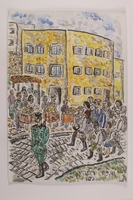
Autobiographical watercolor painting of a group of Jewish men, women, and children under guard
Object
Watercolor sketch by by Arie Singer illustrating a scene dated September 8, 1941, with a soldier leading a group of men, women, and children, dressed mostly in purple with yellow Star of David badges back to the ghetto from prison. They march along a brick street past people standing at tables. It is from a series created from 1985-2000 based upon memories and events from his youth in Vilna and the Glembokie ghetto in Poland and with the partisans in the forests northeast of Vilna, Poland(Vilnius, Lithuania), and in Belarus from 1943-1944. After the Soviet occupation of Vilna in late 1939, nine year old Arie and his family fled to Glembokie (Hlybokaye, Belarus). When Germany invaded Russia in June 1941, the area was assaulted by German mobile killing units, who with the help of the local populace, murdered thousands of Jews. Arie and his mother were forced into the Jewish ghetto. His father, Zvi, age 38, was killed in the massacres at Ponary in 1941. As the pogroms continued into the spring of 1943, Arie and his mother, Chaya, age 35, escaped the ghetto, which was being destroyed by the Germans. They went into hiding in the Nievier Forest near Vilna, where they engaged in partisan activities. The area was liberated by the Red Army in July 1944. After some years in a displaced persons camps, Arie and Chaya emigrated to Israel in the late 1940s. Colonel Singer began creating this series of paintings about his Holocaust experiences in the mid 1980s as rehabilitation following a stroke in 1975.

Autobiographical painting of a round-up of Jews in a ghetto
Object
Watercolor by Arie (Aryeh) Singer depicting a round-up of Jews on Yom Kippur. On the left is a cross section of a house: the lower room shows Arie as a small boy hiding under a table as his aunt and uncle talk with 2 soldiers; in the room above a family prepares for Shabbat dinner. On the landing outside is a crowd of people under thr eatch of a Lithuanian soldeir. It is from a series created from 1985-2000 based upon memories and events from his youth in Vilna and the Glembokie ghetto in Poland and with the partisans in the forests northeast of Vilna, Poland(Vilnius, Lithuania), and in Belarus from 1943-1944. After the Soviet occupation of Vilna in late 1939, nine year old Arie and his family fled to Glembokie (Hlybokaye, Belarus). When Germany invaded Russia in June 1941, the area was assaulted by German mobile killing units, who with the help of the local populace, murdered thousands of Jews. Arie and his mother were forced into the Jewish ghetto. His father, Zvi, age 38, was killed in the massacres at Ponary in 1941. As the pogroms continued into the spring of 1943, Arie and his mother, Chaya, age 35, escaped the ghetto, which was being destroyed by the Germans. They went into hiding in the Nievier Forest near Vilna, where they engaged in partisan activities. The area was liberated by the Red Army in July 1944. After some years in a displaced persons camps, Arie and Chaya emigrated to Israel in the late 1940s. Colonel Singer began creating this series of paintings about his Holocaust experiences in the mid 1980s as rehabilitation following a stroke in 1975.

Watercolor depicting Nazi soldiers shooting Jewish men and boys into a blood streaked dirt ditch
Object
Watercolor painting by Arie Singer of German soldiers shooting boys and men at a large blood streaked dirt pit in the forest. It is from a series created from 1985-2000 based upon memories and events from his youth in Vilna and the Glembokie ghetto in Poland and with the partisans in the forests northeast of Vilna, Poland(Vilnius, Lithuania), and in Belarus from 1943-1944. After the Soviet occupation of Vilna in late 1939, nine year old Arie and his family fled to Glembokie (Hlybokaye, Belarus). When Germany invaded Russia in June 1941, the area was assaulted by German mobile killing units, who with the help of the local populace, murdered thousands of Jews. Arie and his mother were forced into the Jewish ghetto. His father, Zvi, age 38, was killed in the massacres at Ponary in 1941. As the pogroms continued into the spring of 1943, Arie and his mother, Chaya, age 35, escaped the ghetto, which was being destroyed by the Germans. They went into hiding in the Nievier Forest near Vilna, where they engaged in partisan activities. The area was liberated by the Red Army in July 1944. After some years in a displaced persons camps, Arie and Chaya emigrated to Israel in the late 1940s. Colonel Singer began creating this series of paintings about his Holocaust experiences in the mid 1980s as rehabilitation following a stroke in 1975.
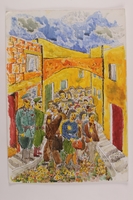
Autobiographical watercolor of people with Star of David badges being marched through a town
Object
Watercolor painting by Arie Singer depicting 2 soldiers with Nazi insignia watching as a crowd of men, women, and children with Star of David badges walk through a street in the ghetto on their way to Ponary. It is from a series created from 1985-2000 based upon memories and events from his youth in Vilna and the Glembokie ghetto in Poland and with the partisans in the forests northeast of Vilna, Poland(Vilnius, Lithuania), and in Belarus from 1943-1944. After the Soviet occupation of Vilna in late 1939, nine year old Arie and his family fled to Glembokie (Hlybokaye, Belarus). When Germany invaded Russia in June 1941, the area was assaulted by German mobile killing units, who with the help of the local populace, murdered thousands of Jews. Arie and his mother were forced into the Jewish ghetto. His father, Zvi, age 38, was killed in the massacres at Ponary in 1941. As the pogroms continued into the spring of 1943, Arie and his mother, Chaya, age 35, escaped the ghetto, which was being destroyed by the Germans. They went into hiding in the Nievier Forest near Vilna, where they engaged in partisan activities. The area was liberated by the Red Army in July 1944. After some years in a displaced persons camps, Arie and Chaya emigrated to Israel in the late 1940s. Colonel Singer began creating this series of paintings about his Holocaust experiences in the mid 1980s as rehabilitation following a stroke in 1975.
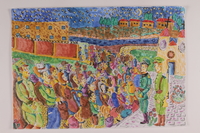
Autobiographical painting of a crowd of people with Judenstern being lectured by German guards
Object
Mixed media work by Arie Singer depicting a long line of children, men, and women with Judenstern being marched under guard into a gated compound. The group in the foreground face 2 men in uniforms with Nazi insignia; one of the men lectures. It is from a series created from 1985-2000 based upon memories and events from his youth in the Glembokie and Vilna ghettos and later as a 13 year old partisan fighter in the forests northeast of Vilna, Poland, (Vilnius, Lithuania) and in Belarus from 1943-1944. After the Soviet occupation of Vilna in late 1939, Arie's family fled to Glembokie (Hlybokaye, Belarus). When Germany invaded Russia in June 1941, the area was assaulted by German mobile killing units, who with the help of the local populace, murdered thousands of Jews. Arie and his mother were forced into the Jewish ghetto. His father, Zvi, age 38, was killed in the massacres at Ponary in 1941. As the pogroms continued into the spring of 1943, Arie and his mother, Chaya, age 35, escaped the ghetto, which was being destroyed by the Germans. They went into hiding in the Nievier Forest near Vilna, where they engaged in partisan activities. The area was liberated by the Red Army in July 1944. After some years in a displaced persons camps, Arie and Chaya emigrated to Israel in the late 1940s. Colonel Singer began creating this series of paintings about his Holocaust experiences in the mid 1980s as rehabilitation following a stroke in 1975.
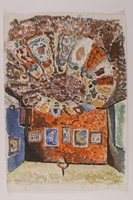
Autobiographical painting of a several Jewish children sleeping in an empty room
Object
Watercolor by Arie Singer depicting children's hostel where as a child in the Glembokie ghetto he slept on the floor with a single blanket. It depicts a circle of children with Stars of David wrapped in blankets on the floor of a large room with several paintings on the wall. It is from a series created from 1985-2000 based upon memories and events from his youth in the Glembokie ghetto and later as a 13 year old partisan fighter in the forests northeast of Vilna, Poland, (Vilnius, Lithuania) and in Belarus from 1943-1944. After the Soviet occupation of Vilna in late 1939, Arie's family fled to Glembokie (Hlybokaye, Belarus). When Germany invaded Russia in June 1941, the area was assaulted by German mobile killing units who, with the help of the local populace, murdered thousands of Jews. Arie and his mother were forced into the Jewish ghetto. His father, Zvi, age 38, was killed in the massacres at Ponary in 1941. As the pogroms continued into the spring of 1943, Arie and his mother, Chaya, age 35, escaped the ghetto, which was being destroyed by the Germans. They went into hiding in the Nievier Forest near Vilna, where they engaged in partisan activities. The area was liberated by the Red Army in July 1944. After some years in a displaced persons camps, Arie and Chaya emigrated to Israel in the late 1940s. Colonel Singer began creating this series of paintings about his Holocaust experiences in the mid 1980s as rehabilitation following a stroke in 1975.
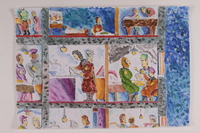
Interior view of daily life in an apartment building in Glembokie ghetto
Object
Watercolor by Arie Singer depicting a midsection of three floors of an apartment building; people with Stars of David on thier brgihtly colored clothes can be doing daily activities, such as eatling, sleeping, and washing dishes. It is from a series created from 1985-2000 based upon memories and events from his youth in the Glembokie ghetto and later as a 13 year old partisan fighter in the forests northeast of Vilna, Poland, (Vilnius, Lithuania) and in Belarus from 1943-1944. After the Soviet occupation of Vilna in late 1939, Arie's family fled to Glembokie (Hlybokaye, Belarus). When Germany invaded Russia in June 1941, the area was assaulted by German mobile killing units, who with the help of the local populace, murdered thousands of Jews. Arie and his mother were forced into the Jewish ghetto. His father, Zvi, age 38, was killed in the massacres at Ponary in 1941. As the pogroms continued into the spring of 1943, Arie and his mother, Chaya, age 35, escaped the ghetto, which was being destroyed by the Germans. They went into hiding in the Nievier Forest near Vilna, where they engaged in partisan activities. The area was liberated by the Red Army in July 1944. After some years in a displaced persons camps, Arie and Chaya emigrated to Israel in the late 1940s. Colonel Singer began creating this series of paintings about his Holocaust experiences in the mid 1980s as rehabilitation following a stroke in 1975.

Watercolor of the burning of massacred Jews in the Ponary Forest by a former child partisan
Object
Watercolor work by Arie Singer depicting uniformed person watched by German soldiers removing bodies from a pit and placing them in a large outdoor fire. It is from a series created from 1985-2000 based upon memories and events from his youth as a 13 year old partisan fighter in the forests northeast of Vilna, Poland, (Vilnius, Lithuania) and in Belarus from 1943-1944. After the Soviet occupation of Vilna in late 1939, Arie's family fled to Glembokie (Hlybokaye, Belarus). When Germany invaded Russia in June 1941, the area was assaulted by German mobile killing units who, with the help of the local populace, murdered thousands of Jews. Arie and his mother were forced into the Jewish ghetto. His father, Zvi, age 38, was killed in the massacres at Ponary in 1941. As the pogroms continued into the spring of 1943, Arie and his mother, Chaya, age 35, escaped the ghetto, which was being destroyed by the Germans. They went into hiding in the Nievier Forest near Vilna, where they engaged in partisan activities. The area was liberated by the Red Army in July 1944. After some years in a displaced persons camps, Arie and Chaya emigrated to Israel in the late 1940s. Colonel Singer began creating this series of paintings about his Holocaust experiences in the mid 1980s as rehabilitation following a stroke in 1975.
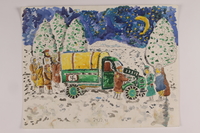
Autobiographical watercolor of a group of Jews standing in the snow near a broken truck
Object
Watercolor by Arie Singer dated December 12, 1941, the night he and his family were transported by the Germans to the ghetto in Glembokie (Hlybokaye, Belarus). It depicts a truck with a swastika broken down in the snow. Arie is pictured with a family group standing behind the truck. It is from a series created from 1985-2000 based upon memories and events from his youth as a 13 year old partisan fighter in the forests northeast of Vilna, Poland, (Vilnius, Lithuania) and in Belarus from 1943-1944. After the Soviet occupation of Vilna in late 1939, Arie's family fled to Glembokie. When Germany invaded Russia in June 1941, the area was assaulted by German mobile killing units who, with the help of the local populace, murdered thousands of Jews. Arie and his mother were forced into the Jewish ghetto. His father, Zvi, age 38, was killed in the massacres at Ponary in 1941. As the pogroms continued into the spring of 1943, Arie and his mother, Chaya, age 35, escaped the ghetto, which was being destroyed by the Germans. They went into hiding in the Nievier Forest near Vilna, where they engaged in partisan activities. The area was liberated by the Soviet Army in July 1944. After some years in a displaced persons camps, Arie and Chaya emigrated to Israel in the late 1940s. Colonel Singer began creating this series of paintings about his Holocaust experiences in the mid 1980s as rehabilitation following a stroke in 1975.

Watercolor painting of 4 men being tortured by German guards
Object
Watercolor by Arie Singer imagining a scene of concentration camp prisoners at Auschwitz being suspended by their arms by German guards. It is from a series of works created from 1985-2000. Unlike this work, most of the works are based upon memories and events from his youth as a 13 year old partisan fighter in the forests northeast of Vilna, Poland, (Vilnius, Lithuania) and in Belarus from 1943-1944. After the Soviet occupation of Vilna in late 1939, Arie's family fled to Glembokie (Hlybokaye, Belarus). When Germany invaded Russia in June 1941, the area was assaulted by German mobile killing units, who with the help of the local populace, murdered thousands of Jews. Arie and his mother were forced into the Jewish ghetto. His father, Zvi, age 38, was killed in the massacres at Ponary in 1941. As the pogroms continued into the spring of 1943, Arie and his mother, Chaya, age 35, escaped the ghetto, which was being destroyed by the Germans. They went into hiding in the Nievier Forest near Vilna, where they engaged in partisan activities. The area was liberated by the Red Army in July 1944. After some years in a displaced persons camps, Arie and Chaya emigrated to Israel in the late 1940s. Colonel Singer began creating this series of paintings about his Holocaust experiences in the mid 1980s as rehabilitation following a stroke in 1975.

Watercolor painting of a man being whipped by German guards as other prisoners wait in line
Object
Watercolor by Arie Singer imagining a scene of concentration camp prisoners at Auschwitz being whipped by German guards. It is from a series of works created from 1985-2000. Unlike this work, most of the works are based upon memories and events from his youth as a 13 year old partisan fighter in the forests northeast of Vilna, Poland, (Vilnius, Lithuania) and in Belarus from 1943-1944. After the Soviet occupation of Vilna in late 1939, Arie's family fled to Glembokie (Hlybokaye, Belarus). When Germany invaded Russia in June 1941, the area was assaulted by German mobile killing units, who with the help of the local populace, murdered thousands of Jews. Arie and his mother were forced into the Jewish ghetto. His father, Zvi, age 38, was killed in the massacres at Ponary in 1941. As the pogroms continued into the spring of 1943, Arie and his mother, Chaya, age 35, escaped the ghetto, which was being destroyed by the Germans. They went into hiding in the Nievier Forest near Vilna, where they engaged in partisan activities. The area was liberated by the Red Army in July 1944. After some years in a displaced persons camps, Arie and Chaya emigrated to Israel in the late 1940s. Colonel Singer began creating this series of paintings about his Holocaust experiences in the mid 1980s as rehabilitation following a stroke in 1975.
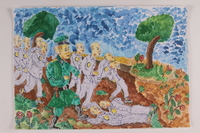
Watercolor of concentration camp prisoners being marched through the woods
Object
Watercolor by Arie Singer imagining a scene of concentration camp prisoners from Auschwitz being marched to exhaustion through the woods by a German guard. It is from a series of works created from 1985-2000. Unlike this work, most of the work is based upon memories and events from his youth as a 13 year old partisan fighter in the forests northeast of Vilna, Poland, (Vilnius, Lithuania) and in Belarus from 1943-1944. After the Soviet occupation of Vilna in late 1939, Arie's family fled to Glembokie (Hlybokaye, Belarus). When Germany invaded Russia in June 1941, the area was assaulted by German mobile killing units, who with the help of the local populace, murdered thousands of Jews. Arie and his mother were forced into the Jewish ghetto. His father, Zvi, age 38, was killed in the massacres at Ponary in 1941. As the pogroms continued into the spring of 1943, Arie and his mother, Chaya, age 35, escaped the ghetto, which was being destroyed by the Germans. They went into hiding in the Nievier Forest near Vilna, where they engaged in partisan activities. The area was liberated by the Red Army in July 1944. After some years in a displaced persons camps, Arie and Chaya emigrated to Israel in the late 1940s. Colonel Singer began creating this series of paintings about his Holocaust experiences in the mid 1980s as rehabilitation following a stroke in 1975.

Watercolor of concentration camp prisoners building a brick wall near barbed wire
Object
Watercolor by Arie Singer imagining a scene of concentration camp prisoners from Auschwitz carrying bricks to construct a brick wall. It is from a series of works created from 1985-2000. Unlike this work, most of the work is based upon memories and events from his youth as a 13 year old partisan fighter in the forests northeast of Vilna, Poland, (Vilnius, Lithuania) and in Belarus from 1943-1944. After the Soviet occupation of Vilna in late 1939, Arie's family fled to Glembokie (Hlybokaye, Belarus). When Germany invaded Russia in June 1941, the area was assaulted by German mobile killing units, who with the help of the local populace, murdered thousands of Jews. Arie and his mother were forced into the Jewish ghetto. His father, Zvi, age 38, was killed in the massacres at Ponary in 1941. As the pogroms continued into the spring of 1943, Arie and his mother, Chaya, age 35, escaped the ghetto, which was being destroyed by the Germans. They went into hiding in the Nievier Forest near Vilna, where they engaged in partisan activities. The area was liberated by the Red Army in July 1944. After some years in a displaced persons camps, Arie and Chaya emigrated to Israel in the late 1940s. Colonel Singer began creating this series of paintings about his Holocaust experiences in the mid 1980s as rehabilitation following a stroke in 1975.
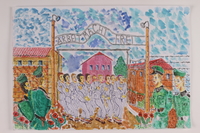
Watercolor of female concentration camp inmates marching through the ARBEIT MACHT FREI gate
Object
Watercolor by Arie Singer imagining prisoners marching through the ARBEIT MACHT FREI gate of a concentration camp. It is from a series of works created from 1985-2000. Unlike this work, most of the work is based upon memories and events from his youth as a 13 year old partisan fighter in the forests northeast of Vilna, Poland, (Vilnius, Lithuania) and in Belarus from 1943-1944. After the Soviet occupation of Vilna in late 1939, Arie's family fled to Glembokie (Hlybokaye, Belarus). When Germany invaded Russia in June 1941, the area was assaulted by German mobile killing units, who with the help of the local populace, murdered thousands of Jews. Arie and his mother were forced into the Jewish ghetto. His father, Zvi, age 38, was killed in the massacres at Ponary in 1941. As the pogroms continued into the spring of 1943, Arie and his mother, Chaya, age 35, escaped the ghetto, which was being destroyed by the Germans. They went into hiding in the Nievier Forest near Vilna, where they engaged in partisan activities. The area was liberated by the Red Army in July 1944. After some years in a displaced persons camps, Arie and Chaya emigrated to Israel in the late 1940s. Colonel Singer began creating this series of paintings about his Holocaust experiences in the mid 1980s as rehabilitation following a stroke in 1975.
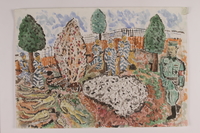
Watercolor of concentration camp prisoners cremating bodies in a fire pit
Object
Watercolor by Arie Singer imagining a scene of concentration camp prisoners burning naked bodies in a large outdoor pit. It is from a series of works created from 1985-2000. Unlike this work, most of the work is based upon memories and events from his youth as a 13 year old partisan fighter in the forests northeast of Vilna, Poland, (Vilnius, Lithuania) and in Belarus from 1943-1944. After the Soviet occupation of Vilna in late 1939, Arie's family fled to Glembokie (Hlybokaye, Belarus). When Germany invaded Russia in June 1941, the area was assaulted by German mobile killing units, who with the help of the local populace, murdered thousands of Jews. Arie and his mother were forced into the Jewish ghetto. His father, Zvi, age 38, was killed in the massacres at Ponary in 1941. As the pogroms continued into the spring of 1943, Arie and his mother, Chaya, age 35, escaped the ghetto, which was being destroyed by the Germans. They went into hiding in the Nievier Forest near Vilna, where they engaged in partisan activities. The area was liberated by the Red Army in July 1944. After some years in a displaced persons camps, Arie and Chaya emigrated to Israel in the late 1940s. Colonel Singer began creating this series of paintings about his Holocaust experiences in the mid 1980s as rehabilitation following a stroke in 1975.
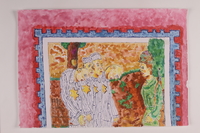
Watercolor of an imagined scene of a US soldier with a group of concentration camp prisoners
Object
Watercolor by Arie Singer imagining the arrival of an American soldier at a concentration camp. It is from a series of works created from 1985-2000. Unlike this work, most of the work is based upon memories and events from his youth as a 13 year old partisan fighter in the forests northeast of Vilna, Poland, (Vilnius, Lithuania) and in Belarus from 1943-1944. After the Soviet occupation of Vilna in late 1939, Arie's family fled to Glembokie (Hlybokaye, Belarus). When Germany invaded Russia in June 1941, the area was assaulted by German mobile killing units, who with the help of the local populace, murdered thousands of Jews. Arie and his mother were forced into the Jewish ghetto. His father, Zvi, age 38, was killed in the massacres at Ponary in 1941. As the pogroms continued into the spring of 1943, Arie and his mother, Chaya, age 35, escaped the ghetto, which was being destroyed by the Germans. They went into hiding in the Nievier Forest near Vilna, where they engaged in partisan activities. The area was liberated by the Red Army in July 1944. After some years in a displaced persons camps, Arie and Chaya emigrated to Israel in the late 1940s. Colonel Singer began creating this series of paintings about his Holocaust experiences in the mid 1980s as rehabilitation following a stroke in 1975.
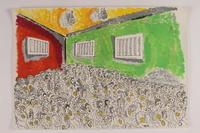
Watercolor of Jewish children, men, and women squeezed into a room with large vents
Object
Watercolor created by Arie Singer around 1985 in memory of those killed by the Germans in the gas chambers at Auschwitz death camp. The names of Arie and his mother, Chaya, who both survived to bear witness to the Holocaust, are written on one wall. After the Soviet occupation of Vilna, Poland (Vilnius, Lithuania), in late 1939, 9 year old Arie and his family fled to Glembokie (Hlybokaye, Belarus). When Germany invaded Russia in June 1941, the area was assaulted by German mobile killing units, who with the help of the local populace, murdered thousands of Jews. Arie and his mother were forced into the Jewish ghetto. His father, Zvi, age 38, was killed in the massacres at Ponary in 1941. As the pogroms continued into the spring of 1943, Arie and his mother, Chaya, age 35, escaped the ghetto, which was being destroyed by the Germans. They went into hiding in the Nievier Forest near Vilna, where they engaged in partisan activities. The area was liberated by the Red Army in July 1944. After some years in a displaced persons camps, Arie and Chaya emigrated to Israel in the late 1940s. Colonel Singer began creating this series of paintings about his Holocaust experiences in the mid 1980s as rehabilitation following a stroke in 1975.
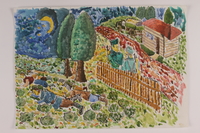
Autobiographical painting of a young boy with partisans hiding from soldiers at night
Object
Watercolor by Arie Singer featuring himself as a young partisan hiding from German soldiers. It is one of a series of works created from 1985-2000 based upon memories and events from his youth as a 13 year old partisan fighter in the forests northeast of Vilna, Poland, (Vilnius, Lithuania) and in Belarus from 1943-1944. The work depicts Aryeh and other partisans hiding from soldiers. After the Soviet occupation of Vilna in late 1939, Arie's family fled to Glembokie (Hlybokaye, Belarus). When Germany invaded Russia in June 1941, the area was assaulted by German mobile killing units, who with the help of the local populace, murdered thousands of Jews. Arie and his mother were forced into the Jewish ghetto. His father, Zvi, age 38, was killed in the massacres at Ponary in 1941. As the pogroms continued into the spring of 1943, Arie and his mother, Chaya, age 35, escaped the ghetto, which was being destroyed by the Germans. They went into hiding in the Nievier Forest near Vilna, where they engaged in partisan activities. The area was liberated by the Red Army in July 1944. After some years in a displaced persons camps, Arie and Chaya emigrated to Israel in the late 1940s. Colonel Singer began creating this series of paintings about his Holocaust experiences in the mid 1980s as rehabilitation following a stroke in 1975.

Autobiographical watercolor of 2 Nazi soldiers passing a partisan compound in the forest
Object
Watercolor created by Arie Singer dated May 2, 1943, depicting two Nazi soldiers on patrol passing hidden partisans buildings in the forest. It is from a series created from 1985-2000 based upon memories and events from his youth as a 13 year old partisan fighter in the forests northeast of Vilna, Poland, (Vilnius, Lithuania) and in Belarus from 1943-1944. It is from a series created from 1985-2000 based upon memories and events from his youth as a 13 year old partisan fighter in the forests northeast of Vilna, Poland, (Vilnius, Lithuania) and in Belarus from 1943-1944. After the Soviet occupation of Vilna, Poland (Vilnius, Lithuania), in late 1939, nine year old Arie and his family fled to Glembokie (Hlybokaye, Belarus). When Germany invaded Russia in June 1941, the area was assaulted by German mobile killing units, who with the help of the local populace, murdered thousands of Jews. Arie and his mother were forced into the Jewish ghetto. His father, Zvi, age 38, was killed in the massacres at Ponary in 1941. As the pogroms continued into the spring of 1943, Arie and his mother, Chaya, age 35, escaped the ghetto, which was being destroyed by the Germans. They went into hiding in the Nievier Forest near Vilna, where they engaged in partisan activities. The area was liberated by the Red Army in July 1944. After some years in a displaced persons camps, Arie and Chaya emigrated to Israel in the late 1940s. Colonel Singer began creating this series of paintings about his Holocaust experiences in the mid 1980s as rehabilitation following a stroke in 1975.

Autobiographical watercolor of Jewish partisans around a fire in a snow covered forest at night
Object
Watercolor created by Arie Singer depicting a night scene of himself with a large group of men, women, and children with Star of David badges warming themselves at a bonfire. It is from a series created from 1985-2000 based upon memories and events from his youth as a 13 year old partisan fighter in the forests northeast of Vilna, Poland, (Vilnius, Lithuania) and in Belarus from 1943-1944. It is from a series created from 1985-2000 based upon memories and events from his youth as a 13 year old partisan fighter in the forests northeast of Vilna, Poland, (Vilnius, Lithuania) and in Belarus from 1943-1944. After the Soviet occupation of Vilna, Poland (Vilnius, Lithuania), in late 1939, nine year old Arie and his family fled to Glembokie (Hlybokaye, Belarus). When Germany invaded Russia in June 1941, the area was assaulted by German mobile killing units, who with the help of the local populace, murdered thousands of Jews. Arie and his mother were forced into the Jewish ghetto. His father, Zvi, age 38, was killed in the massacres at Ponary in 1941. As the pogroms continued into the spring of 1943, Arie and his mother, Chaya, age 35, escaped the ghetto, which was being destroyed by the Germans. They went into hiding in the Nievier Forest near Vilna, where they engaged in partisan activities. The area was liberated by the Red Army in July 1944. After some years in a displaced persons camps, Arie and Chaya emigrated to Israel in the late 1940s. Colonel Singer began creating this series of paintings about his Holocaust experiences in the mid 1980s as rehabilitation following a stroke in 1975.

Autobiographical watercolor of Jewish partisans around a fire in a snow covered forest
Object
Watercolor created by Arie Singer depicting a daylight scene of a large group of men, women, and children with Star of David badges warming themselves at a bonfire. It is from a series created from 1985-2000 based upon memories and events from his youth as a 13 year old partisan fighter in the forests northeast of Vilna, Poland, (Vilnius, Lithuania) and in Belarus from 1943-1944. After the Soviet occupation of Vilna in late 1939, Arie's family fled to Glembokie (Hlybokaye, Belarus). When Germany invaded Russia in June 1941, the area was assaulted by German mobile killing units, who with the help of the local populace, murdered thousands of Jews. Arie and his mother were forced into the Jewish ghetto. His father, Zvi, age 38, was killed in the massacres at Ponary in 1941. As the pogroms continued into the spring of 1943, Arie and his mother, Chaya, age 35, escaped the ghetto, which was being destroyed by the Germans. They went into hiding in the Nievier Forest near Vilna, where they engaged in partisan activities. The area was liberated by the Red Army in July 1944. After some years in a displaced persons camps, Arie and Chaya emigrated to Israel in the late 1940s. Colonel Singer began creating this series of paintings about his Holocaust experiences in the mid 1980s as rehabilitation following a stroke in 1975.

Watercolor depicting partisans shooting at Nazi soldiers driving through the forest
Object
Watercolor created by Arie Singer depicting a car carrying Nazi soldiers driving along a forest road as two partisans, captioned cousin and uncle, fire machine guns at them from within the trees. It is from a series created from 1985-2000 based upon memories and events from his youth as a 13 year old partisan fighter in the forests northeast of Vilna, Poland, (Vilnius, Lithuania) and in Belarus from 1943-1944. After the Soviet occupation of Vilna, Poland (Vilnius, Lithuania), in late 1939, nine year old Arie and his family fled to Glembokie (Hlybokaye, Belarus). When Germany invaded Russia in June 1941, the area was assaulted by German mobile killing units, who with the help of the local populace, murdered thousands of Jews. Arie and his mother were forced into the Jewish ghetto. His father, Zvi, age 38, was killed in the massacres at Ponary in 1941. As the pogroms continued into the spring of 1943, Arie and his mother, Chaya, age 35, escaped the ghetto, which was being destroyed by the Germans. They went into hiding in the Nievier Forest near Vilna, where they engaged in partisan activities. The area was liberated by the Red Army in July 1944. After some years in a displaced persons camps, Arie and Chaya emigrated to Israel in the late 1940s. Colonel Singer began creating this series of paintings about his Holocaust experiences in the mid 1980s as rehabilitation following a stroke in 1975.
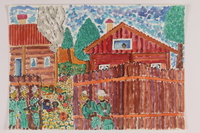
Watercolor depicting armed German soldiers looking through a gate at the bodies of dead Jews
Object
Watercolor created by Arie Singer imagining the liquidation of the Glembokie ghetto, with everything burning and someone escaping. It is from a series created from 1985-2000 based upon memories and events from his youth as a 13 year old partisan fighter in the forests northeast of Vilna, Poland, (Vilnius, Lithuania) and in Belarus from 1943-1944. After the Soviet occupation of Vilna in late 1939, Arie's family fled to Glembokie (Hlybokaye, Belarus). When Germany invaded Russia in June 1941, the area was assaulted by German mobile killing units, who with the help of the local populace, murdered thousands of Jews. Arie and his mother were forced into the Jewish ghetto. His father, Zvi, age 38, was killed in the massacres at Ponary in 1941. As the pogroms continued into the spring of 1943, Arie and his mother, Chaya, age 35, escaped the ghetto, which was being destroyed by the Germans. They went into hiding in the Nievier Forest near Vilna, where they engaged in partisan activities. The area was liberated by the Red Army in July 1944. After some years in a displaced persons camps, Arie and Chaya emigrated to Israel in the late 1940s. Colonel Singer began creating this series of paintings about his Holocaust experiences in the mid 1980s as rehabilitation following a stroke in 1975.
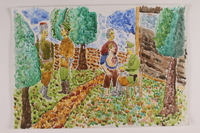
Autobiographical painting of a youth getting a chest wound treated by a doctor
Object
Watercolor created by Arie Singer depicting himself as a young boy having a bloody injury on his chest examined by a doctor as his mother looks on and two partisan fighters stand guard. The doctor, who was German, told Arie (Aryeh) that he would be fine. It is from a series created from 1985-2000 based upon memories and events from his youth as a 13 year old partisan fighter in the forests northeast of Vilna, Poland, (Vilnius, Lithuania) and in Belarus from 1943-1944. It is from a series created from 1985-2000 based upon memories and events from his youth as a 13 year old partisan fighter in the forests northeast of Vilna, Poland, (Vilnius, Lithuania) and in Belarus from 1943-1944. After the Soviet occupation of Vilna, Poland (Vilnius, Lithuania), in late 1939, nine year old Arie and his family fled to Glembokie (Hlybokaye, Belarus). When Germany invaded Russia in June 1941, the area was assaulted by German mobile killing units, who with the help of the local populace, murdered thousands of Jews. Arie and his mother were forced into the Jewish ghetto. His father, Zvi, age 38, was killed in the massacres at Ponary in 1941. As the pogroms continued into the spring of 1943, Arie and his mother, Chaya, age 35, escaped the ghetto, which was being destroyed by the Germans. They went into hiding in the Nievier Forest near Vilna, where they engaged in partisan activities. The area was liberated by the Red Army in July 1944. After some years in a displaced persons camps, Arie and Chaya emigrated to Israel in the late 1940s. Colonel Singer began creating this series of paintings about his Holocaust experiences in the mid 1980s as rehabilitation following a stroke in 1975.
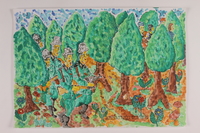
Autobiographical watercolor depicting armed Nazi soldiers searching a forest as partisans escape
Object
Watercolor created by Arie Singer depicting a thick forest with a squad of armed German soldiers marching in the foreground as a small group of partisans disappear in the background. It is from a series created from 1985-2000 based upon memories and events from his youth as a 13 year old partisan fighter in the forests northeast of Vilna, Poland, (Vilnius, Lithuania) and in Belarus from 1943-1944. After the Soviet occupation of Vilna, Poland (Vilnius, Lithuania), in late 1939, 9 year old Arie and his family fled to Glembokie (Hlybokaye, Belarus). When Germany invaded Russia in June 1941, the area was assaulted by German mobile killing units, who with the help of the local populace, murdered thousands of Jews. Arie and his mother were forced into the Jewish ghetto. His father, Zvi, age 38, was killed in the massacres at Ponary in 1941. As the pogroms continued into the spring of 1943, Arie and his mother, Chaya, age 35, escaped the ghetto, which was being destroyed by the Germans. They went into hiding in the Nievier Forest near Vilna, where they engaged in partisan activities. The area was liberated by the Red Army in July 1944. After some years in a displaced persons camps, Arie and Chaya emigrated to Israel in the late 1940s. Colonel Singer began creating this series of paintings about his Holocaust experiences in the mid 1980s as rehabilitation following a stroke in 1975.
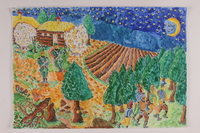
Autobiographical watercolor of a young boy and partisans escaping their burning camp
Object
Watercolor by Arie Singer of himself as a young boy with four other partisans escaping into the forest after German soldiers set their cabins on fire. It is from a series created from 1985-2000 based upon memories and events from his youth as a 13 year old partisan fighter in the forests northeast of Vilna, Poland, (Vilnius, Lithuania) and in Belarus from 1943-1944. After the Soviet occupation of Vilna in late 1939, Arie's family fled to Glembokie (Hlybokaye, Belarus). When Germany invaded Russia in June 1941, the area was assaulted by German mobile killing units, who with the help of the local populace, murdered thousands of Jews. Arie and his mother were forced into the Jewish ghetto. His father, Zvi, age 38, was killed in the massacres at Ponary in 1941. As the pogroms continued into the spring of 1943, Arie and his mother, Chaya, age 35, escaped the ghetto, which was being destroyed by the Germans. They went into hiding in the Nievier Forest near Vilna, where they engaged in partisan activities. The area was liberated by the Red Army in July 1944. After some years in a displaced persons camps, Arie and Chaya emigrated to Israel in the late 1940s. Colonel Singer began creating this series of paintings about his Holocaust experiences in the mid 1980s as rehabilitation following a stroke in 1975.

Autobiographical watercolor of a young boy marching out on patrol with his partian group
Object
Watercolor by Aries Singer depicting himself as a boy with his mother Chaya and a group of partisans on a night march. It is from a series created from 1985-2000 based upon memories and events from his youth as a 13 year old partisan fighter in the forests northeast of Vilna, Poland, (Vilnius, Lithuania) and in Belarus from 1943-1944. After the Soviet occupation of Vilna in late 1939, Arie's family fled to Glembokie (Hlybokaye, Belarus). When Germany invaded Russia in June 1941, the area was assaulted by German mobile killing units, who with the help of the local populace, murdered thousands of Jews. Arie and his mother were forced into the Jewish ghetto. His father, Zvi, age 38, was killed in the massacres at Ponary in 1941. As the pogroms continued into the spring of 1943, Arie and his mother, Chaya, age 35, escaped the ghetto, which was being destroyed by the Germans. They went into hiding in the Nievier Forest near Vilna, where they engaged in partisan activities. The area was liberated by the Red Army in July 1944. After some years in a displaced persons camps, Arie and Chaya emigrated to Israel in the late 1940s. Colonel Singer began creating this series of paintings about his Holocaust experiences in the mid 1980s as rehabilitation following a stroke in 1975.
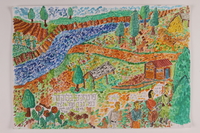
Autobiographical watercolor of a partisan standoff against German soldiers
Object
Watercolor by Arie Singer depicting himself at thirteen years, his mother, Chaya, a friend, Polania, and two other partisans leaving their camp clearing to go into the forest on patrol. It is from a series created from 1985-2000 based upon memories and events from his youth as a partisan fighter in the forests northeast of Vilna, Poland, (Vilnius, Lithuania) and in Belarus from 1943-1944. After the Soviet occupation of Vilna in late 1939, Arie's family fled to Glembokie (Hlybokaye, Belarus). When Germany invaded Russia in June 1941, the area was assaulted by German mobile killing units, who with the help of the local populace, murdered thousands of Jews. Arie and his mother were forced into the Jewish ghetto. His father, Zvi, age 38, was killed in the massacres at Ponary in 1941. As the pogroms continued into the spring of 1943, Arie and his mother, Chaya, age 35, escaped the ghetto, which was being destroyed by the Germans. They went into hiding in the Nievier Forest near Vilna, where they engaged in partisan activities. The area was liberated by the Red Army in July 1944. After some years in a displaced persons camps, Arie and Chaya emigrated to Israel in the late 1940s. Colonel Singer began creating this series of paintings about his Holocaust experiences in the mid 1980s as rehabilitation following a stroke in 1975.
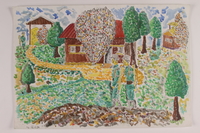
Autobiographical watercolor of two German soldiers unknowingly passing a partisan camp
Object
Watercolor by Arie Singer depicting two German soldiers on patrol walking past a partisan encampment. It is from a series created from 1985-2000 based upon memories and events from his youth as a 13 year old partisan fighter in the forests northeast of Vilna, Poland, (Vilnius, Lithuania) and in Belarus from 1943-1944. After the Soviet occupation of Vilna in late 1939, Arie's family fled to Glembokie (Hlybokaye, Belarus). When Germany invaded Russia in June 1941, the area was assaulted by German mobile killing units, who with the help of the local populace, murdered thousands of Jews. Arie and his mother were forced into the Jewish ghetto. His father, Zvi, age 38, was killed in the massacres at Ponary in 1941. As the pogroms continued into the spring of 1943, Arie and his mother, Chaya, age 35, escaped the ghetto, which was being destroyed by the Germans. They went into hiding in the Nievier Forest near Vilna, where they engaged in partisan activities. The area was liberated by the Red Army in July 1944. After some years in a displaced persons camps, Arie and Chaya emigrated to Israel in the late 1940s. Colonel Singer began creating this series of paintings about his Holocaust experiences in the mid 1980s as rehabilitation following a stroke in 1975.

Autobiographical painting depicting partisans changing shifts for patrol
Object
Watercolor by Arie Singer depicting members of his partisan group switching patrols with the Russians in the camp. It is from a series created from 1985-2000 based upon memories and events from his youth as a 13 year old partisan fighter in the forests northeast of Vilna, Poland, (Vilnius, Lithuania) and in Belarus from 1943-1944. After the Soviet occupation of Vilna in late 1939, Arie's family fled to Glembokie (Hlybokaye, Belarus). When Germany invaded Russia in June 1941, the area was assaulted by German mobile killing units, who with the help of the local populace, murdered thousands of Jews. Arie and his mother were forced into the Jewish ghetto. His father, Zvi, age 38, was killed in the massacres at Ponary in 1941. As the pogroms continued into the spring of 1943, Arie and his mother, Chaya, age 35, escaped the ghetto, which was being destroyed by the Germans. They went into hiding in the Nievier Forest near Vilna, where they engaged in partisan activities. The area was liberated by the Red Army in July 1944. After some years in a displaced persons camps, Arie and Chaya emigrated to Israel in the late 1940s. Colonel Singer began creating this series of paintings about his Holocaust experiences in the mid 1980s as rehabilitation following a stroke in 1975.

Autobiographical watercolor drawing of a partisan patrol passing through a tilled field
Object
Mixed media work by Arie Singer depicting himself as a young boy walking through a tilled field with a group of partisans. It is from a series created from 1985-2000 based upon memories and events from his youth as a 13 year old partisan fighter in the forests northeast of Vilna, Poland, (Vilnius, Lithuania) and in Belarus from 1943-1944. After the Soviet occupation of Vilna in late 1939, Arie's family fled to Glembokie (Hlybokaye, Belarus). When Germany invaded Russia in June 1941, the area was assaulted by German mobile killing units, who with the help of the local populace, murdered thousands of Jews. Arie and his mother were forced into the Jewish ghetto. His father, Zvi, age 38, was killed in the massacres at Ponary in 1941. As the pogroms continued into the spring of 1943, Arie and his mother, Chaya, age 35, escaped the ghetto, which was being destroyed by the Germans. They went into hiding in the Nievier Forest near Vilna, where they engaged in partisan activities. The area was liberated by the Red Army in July 1944. After some years in a displaced persons camps, Arie and Chaya emigrated to Israel in the late 1940s. Colonel Singer began creating this series of paintings about his Holocaust experiences in the mid 1980s as rehabilitation following a stroke in 1975.

Autobiographical watercolor of Aryeh and some partisans watching a Soviet plane
Object
Watercolor by Arie Singer depicting his 13 year old self, in yellow shirt with orange hair, with a line of partisans on August 28-September 1, 1943, standing in a tilled field at night as a Soviet plane with searchlights flies above. It is from a series created from 1985-2000 based upon memories and events from his youth as a 13 year old partisan fighter in the forests northeast of Vilna, Poland, (Vilnius, Lithuania) and in Belarus from 1943-1944. After the Soviet occupation of Vilna in late 1939, Arie's family fled to Glembokie (Hlybokaye, Belarus). When Germany invaded Russia in June 1941, the area was assaulted by German mobile killing units, who with the help of the local populace, murdered thousands of Jews. Arie and his mother were forced into the Jewish ghetto. His father, Zvi, age 38, was killed in the massacres at Ponary in 1941. As the pogroms continued into the spring of 1943, Arie and his mother, Chaya, age 35, escaped the ghetto, which was being destroyed by the Germans. They went into hiding in the Nievier Forest near Vilna, where they engaged in partisan activities. The area was liberated by the Red Army in July 1944. After some years in a displaced persons camps, Arie and Chaya emigrated to Israel in the late 1940s. Colonel Singer began creating this series of paintings about his Holocaust experiences in the mid 1980s as rehabilitation following a stroke in 1975.

Autobiographical watercolor of partisans around a campfire
Object
Watercolor by Arie Singer depicting himself with orange hair and shirt, his mother Chaya in a red skirt, and Yakov Roderman with a small group of partisans at a campfire outside their forest dugout. It is from a series created from 1985-2000 based upon memories and events from his youth as a 13 year old partisan fighter in the forests northeast of Vilna, Poland, (Vilnius, Lithuania) and in Belarus from 1943-1944. After the Soviet occupation of Vilna in late 1939, Arie's family fled to Glembokie (Hlybokaye, Belarus). When Germany invaded Russia in June 1941, the area was assaulted by German mobile killing units, who with the help of the local populace, murdered thousands of Jews. Arie and his mother were forced into the Jewish ghetto. His father, Zvi, age 38, was killed in the massacres at Ponary in 1941. As the pogroms continued into the spring of 1943, Arie and his mother, Chaya, age 35, escaped the ghetto, which was being destroyed by the Germans. They went into hiding in the Nievier Forest near Vilna, where they engaged in partisan activities. The area was liberated by the Red Army in July 1944. After some years in a displaced persons camps, Arie and Chaya emigrated to Israel in the late 1940s. Colonel Singer began creating this series of paintings about his Holocaust experiences in the mid 1980s as rehabilitation following a stroke in 1975.

Watercolor of a man standing before a partisan firing squad by a former child partisan
Object
Watercolor by Arie Singer depicting a blindfolded man standing before a partisan firing squad. It is from a series created from 1985-2000 based upon memories and events from his youth as a 13 year old partisan fighter in the forests northeast of Vilna, Poland, (Vilnius, Lithuania) and in Belarus from 1943-1944. After the Soviet occupation of Vilna in late 1939, Arie's family fled to Glembokie (Hlybokaye, Belarus). When Germany invaded Russia in June 1941, the area was assaulted by German mobile killing units, who with the help of the local populace, murdered thousands of Jews. Arie and his mother were forced into the Jewish ghetto. His father, Zvi, age 38, was killed in the massacres at Ponary in 1941. As the pogroms continued into the spring of 1943, Arie and his mother, Chaya, age 35, escaped the ghetto, which was being destroyed by the Germans. They went into hiding in the Nievier Forest near Vilna, where they engaged in partisan activities. The area was liberated by the Red Army in July 1944. After some years in a displaced persons camps, Arie and Chaya emigrated to Israel in the late 1940s. Colonel Singer began creating this series of paintings about his Holocaust experiences in the mid 1980s as rehabilitation following a stroke in 1975.

Watercolor of a man using a short wave radio at night by a former child partisan
Object
Watercolor by Arie Singer depicting German soldiers using a short wave radio at night in the forest. It is from a series created from 1985-2000 based upon memories and events from his youth as a 13 year old partisan fighter in the forests northeast of Vilna, Poland, (Vilnius, Lithuania) and in Belarus from 1943-1944. After the Soviet occupation of Vilna in late 1939, Arie's family fled to Glembokie (Hlybokaye, Belarus). When Germany invaded Russia in June 1941, the area was assaulted by German mobile killing units, who with the help of the local populace, murdered thousands of Jews. Arie and his mother were forced into the Jewish ghetto. His father, Zvi, age 38, was killed in the massacres at Ponary in 1941. As the pogroms continued into the spring of 1943, Arie and his mother, Chaya, age 35, escaped the ghetto, which was being destroyed by the Germans. They went into hiding in the Nievier Forest near Vilna, where they engaged in partisan activities. The area was liberated by the Red Army in July 1944. After some years in a displaced persons camps, Arie and Chaya emigrated to Israel in the late 1940s. Colonel Singer began creating this series of paintings about his Holocaust experiences in the mid 1980s as rehabilitation following a stroke in 1975.

Scenes of German brutality in the ghetto as imagined by a former child partisan
Object
Watercolor by Arie Singer featuring scenes of torture he may have witnessed or heard about as a boy in the Glembokie ghetto. It is from a series created from 1985-2000 based upon memories and events from his youth as a 13 year old partisan fighter in the forests northeast of Vilna, Poland, (Vilnius, Lithuania) and in Belarus from 1943-1944. After the Soviet occupation of Vilna in late 1939, Arie's family fled to Glembokie (Hlybokaye, Belarus). When Germany invaded Russia in June 1941, the area was assaulted by German mobile killing units, who with the help of the local populace, murdered thousands of Jews. Arie and his mother were forced into the Jewish ghetto. His father, Zvi, age 38, was killed in the massacres at Ponary in 1941. As the pogroms continued into the spring of 1943, Arie and his mother, Chaya, age 35, escaped the ghetto, which was being destroyed by the Germans. They went into hiding in the Nievier Forest near Vilna, where they engaged in partisan activities. The area was liberated by the Red Army in July 1944. After some years in a displaced persons camps, Arie and Chaya emigrated to Israel in the late 1940s. Colonel Singer began creating this series of paintings about his Holocaust experiences in the mid 1980s as rehabilitation following a stroke in 1975.
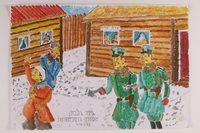
Autobiographical painting of German soldiers shooting a youth by a former child partisan
Object
Watercolor by Arie Singer depicting himself and his cousin Edith watching out a window as German police shoot a youth with a bandaged head in the back in the Glembokie Ghetto. It is from a series created from 1985-2000 based upon memories and events from his youth as a 13 year old partisan fighter in the forests northeast of Vilna, Poland, (Vilnius, Lithuania) and in Belarus from 1943-1944. After the Soviet occupation of Vilna in late 1939, Arie's family fled to Glembokie (Hlybokaye, Belarus). When Germany invaded Russia in June 1941, the area was assaulted by German mobile killing units, who with the help of the local populace, murdered thousands of Jews. Arie and his mother were forced into the Jewish ghetto. His father, Zvi, age 38, was killed in the massacres at Ponary in 1941. As the pogroms continued into the spring of 1943, Arie and his mother, Chaya, age 35, escaped the ghetto, which was being destroyed by the Germans. They went into hiding in the Nievier Forest near Vilna, where they engaged in partisan activities. The area was liberated by the Red Army in July 1944. After some years in a displaced persons camps, Arie and Chaya emigrated to Israel in the late 1940s. Colonel Singer began creating this series of paintings about his Holocaust experiences in the mid 1980s as rehabilitation following a stroke in 1975.

Autobiographical sketch of a boy in bed when soldiers raid the home by a former child partisan
Object
Watercolor in grays and blacks by Arie Singer depicting a young boy in bed being looked at by a couple with Jewish stars and 2 soldiers with drawn pistols. It is from a series created from 1985-2000 based upon memories and events from his youth in the Glembokie ghetto in 1941-1944. After the Soviet occupation of Vilna, Poland, in late 1939, Arie's family fled to Glembokie (Hlybokaye, Belarus). When Germany invaded he Soviet Union in June 1941, the area was assaulted by German mobile killing units, who with the help of the local populace, murdered thousands of Jews. Arie and his mother were forced into the Jewish ghetto. His father, Zvi, age 38, was killed in the massacres at Ponary in 1941. As the pogroms continued into the spring of 1943, Arie and his mother, Chaya, age 35, escaped the ghetto, which was being destroyed by the Germans. They went into hiding in the Nievier Forest near Vilna, where they engaged in partisan activities. The area was liberated by the Red Army in July 1944. After some years in a displaced persons camps, Arie and Chaya emigrated to Israel in the late 1940s. Colonel Singer began creating this series of paintings about his Holocaust experiences in the mid 1980s as rehabilitation following a stroke in 1975.
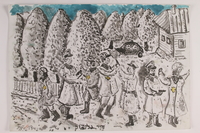
Autobiographical monochrome sketch of soldiers arresting a Jewish family by a former child partisan
Object
Watercolor in grays and blacks by Arie Singer about his first night with the partisans, when one was wounded. It depicts group of adults and children wearing yellow Stars of David being arrested by Nazi soldiers with pistols. It is from a series created from 1985-2000 based upon memories and events from his youth in the Glembokie/Vilna ghettos and as a 13 year old partisan in the forest from 1941-1944. After the Soviet occupation of Vilna in late 1939, Arie's family fled to Glembokie (Hlybokaye, Belarus). When Germany invaded Russia in June 1941, the area was assaulted by German mobile killing units, who with the help of the local populace, murdered thousands of Jews. Arie and his mother were forced into the Jewish ghetto. His father, Zvi, age 38, was killed in the massacres at Ponary in 1941. As the pogroms continued into the spring of 1943, Arie and his mother, Chaya, age 35, escaped the ghetto, which was being destroyed by the Germans. They went into hiding in the Nievier Forest near Vilna, where they engaged in partisan activities. The area was liberated by the Red Army in July 1944. After some years in a displaced persons camps, Arie and Chaya emigrated to Israel in the late 1940s. Colonel Singer began creating this series of paintings about his Holocaust experiences in the mid 1980s as rehabilitation following a stroke in 1975.
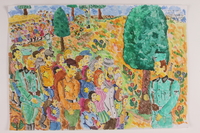
Autobiographical watercolor of soldiers escorting a long, long line of Jews by a former child partisan
Object
Watercolor by Arie Singer depicting soldiers guarding a seemingly endless column of men, women, and children with Star of David badges near Kiev. It is from a series created from 1985-2000 based upon memories and events from his youth as a 13 year old partisan fighter in the forests northeast of Vilna, Poland, (Vilnius, Lithuania) and in Belarus from 1943-1944. After the Soviet occupation of Vilna in late 1939, Arie's family fled to Glembokie (Hlybokaye, Belarus). When Germany invaded Russia in June 1941, the area was assaulted by German mobile killing units, who with the help of the local populace, murdered thousands of Jews. Arie and his mother were forced into the Jewish ghetto. His father, Zvi, age 38, was killed in the massacres at Ponary in 1941. As the pogroms continued into the spring of 1943, Arie and his mother, Chaya, age 35, escaped the ghetto, which was being destroyed by the Germans. They went into hiding in the Nievier Forest near Vilna, where they engaged in partisan activities. The area was liberated by the Red Army in July 1944. After some years in a displaced persons camps, Arie and Chaya emigrated to Israel in the late 1940s. Colonel Singer began creating this series of paintings about his Holocaust experiences in the mid 1980s as rehabilitation following a stroke in 1975.

Autobiographical watercolor of a Jewish family in their forest hideout done by a former child partisan
Object
Watercolor of a partisan Jewish family, including Aryeh and his cousin Edith, eating dinner in their dugout painted by Arie Singer. It is from a series created from 1985-2000 based upon memories as a 13 year old partisan fighter in the forests near Vilna, Poland, (Vilnius, Lithuania) and in Belarus from 1943-1944. After the Soviet occupation of Vilna in late 1939, Arie's family fled to Glembokie (Hlybokaye, Belarus). When Germany invaded in June 1941, German mobile killing units, with the help of the local populace, murdered thousands of Jews. Arie and his mother were forced into the Jewish ghetto. His father, Zvi, age 38, was killed in the Ponary massacres in 1941. Arie and his mother, Chaya, age 35, escaped during liquidation of the ghetto. They went into hiding in the Nievier Forest near Vilna, and joined the partisans. The area was liberated by the Red Army in July 1944. After years in displaced persons camps, Arie and Chaya emigrated to Israel in the late 1940s. Colonel Singer began creating this series of paintings about his Holocaust experiences in the mid 1980s as rehabilitation following a stroke in 1975.
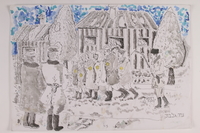
Watercolor of ews being expelled from a village done by a former child partisan
Object
Grayscale watercolor with a 13 year old Aryeh and a group of people with yellow Judenstern being marched out of a village by men with whips. It was painted by Arie Singer, part of a series created 1985-2000 based upon memories as a 13 year old partisan fighter in the forests near Vilna, Poland, (Vilnius, Lithuania) and Belarus circa 1943-1944. After the Soviet occupation of Vilna in late 1939, Arie's family fled to Glembokie (Hlybokaye, Belarus). When Germany invaded in June 1941, German mobile killing units, with the help of the local populace, murdered thousands of Jews. Arie and his mother were forced into the Jewish ghetto. His father, Zvi, age 38, was killed in the Ponary massacres in 1941. Arie and his mother, Chaya, age 35, escaped during liquidation of the ghetto. They went into hiding in the Nievier Forest near Vilna, and joined the partisans. The area was liberated by the Red Army in July 1944. After years in displaced persons camps, Arie and Chaya emigrated to Israel in the late 1940s. Colonel Singer began creating this series of paintings about his Holocaust experiences in the mid 1980s as rehabilitation following a stroke in 1975.

Autobiographcal watercolor of a German officer and young woman conversing
Object
Watercolor of a young woman, Miriam Singer, talking to a German officer as her cousin Arie walks nearby. It was created by Arie Singer, part of a series circa 1985-2000, based upon his memories as a 13 year old partisan fighter in the forests near Vilna, Poland, (Vilnius, Lithuania) and Belarus circa 1943-1944. After the Soviet occupation of Vilna in late 1939, Arie's family fled to Glembokie (Hlybokaye, Belarus). When Germany invaded in June 1941, German mobile killing units, with the help of the local populace, murdered thousands of Jews. Arie and his mother were forced into the Jewish ghetto. His father, Zvi, age 38, was killed in the Ponary massacres in 1941. Arie and his mother, Chaya, age 35, escaped during liquidation of the ghetto. They went into hiding in the Nievier Forest near Vilna, and joined the partisans. The area was liberated by the Red Army in July 1944. After years in displaced persons camps, Arie and Chaya emigrated to Israel in the late 1940s. Colonel Singer began creating this series of paintings about his Holocaust experiences in the mid 1980s as rehabilitation following a stroke in 1975.
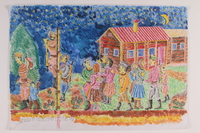
Autobiographocal watercolor of Jewish partisans climbing the fence out of the ghetto
Object
Watercolor of partisans with yellow star of David badges leaving over the fence after visiting the ghetto. It was created by Arie Singer, part of a series circa 1985-2000, based upon his memories as a 13 year old partisan fighter in the forests near Vilna, Poland, (Vilnius, Lithuania) and Belarus circa 1943-1944. After the Soviet occupation of Vilna in late 1939, Arie's family fled to Glembokie (Hlybokaye, Belarus). When Germany invaded in June 1941, German mobile killing units, with the help of the local populace, murdered thousands of Jews. Arie and his mother were forced into the Jewish ghetto. His father, Zvi, age 38, was killed in the Ponary massacres in 1941. Arie and his mother, Chaya, age 35, escaped during liquidation of the ghetto. They went into hiding in the Nievier Forest near Vilna, and joined the partisans. The area was liberated by the Red Army in July 1944. After years in displaced persons camps, Arie and Chaya emigrated to Israel in the late 1940s. Colonel Singer began creating this series of paintings about his Holocaust experiences in the mid 1980s as rehabilitation following a stroke in 1975.

Autobiographical watercolor of a Jewish family having a formal dinner
Object
Grayscale watercolor of a dozen people, including Arie with his orange hair, with yellow Star of David badges seated around a long table. It was created by Arie Singer, part of a series circa 1985-2000, based upon his memories as a 13 year old partisan fighter in the forests near Vilna, Poland, (Vilnius, Lithuania) and Belarus circa 1943-1944. After the Soviet occupation of Vilna in late 1939, Arie's family fled to Glembokie (Hlybokaye, Belarus). When Germany invaded in June 1941, German mobile killing units, with the help of the local populace, murdered thousands of Jews. Arie and his mother were forced into the Jewish ghetto. His father, Zvi, age 38, was killed in the Ponary massacres in 1941. Arie and his mother, Chaya, age 35, escaped during liquidation of the ghetto. They went into hiding in the Nievier Forest near Vilna, and joined the partisans. The area was liberated by the Red Army in July 1944. After years in dp camps, Arie and Chaya emigrated to Israel in the late 1940s. Colonel Singer began creating this series of paintings about his Holocaust experiences in the mid 1980s as rehabilitation following a stroke in 1975.
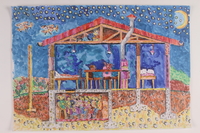
Watercolor of people with Judenstern in an underground shelter done by a former child partisan
Object
Multicolored watercolor of people wearing yellow Star of David badges crammed into an underground shelter. It was created by Arie Singer, part of a series circa 1985-2000, based upon his memories as a 13 year old partisan fighter in the forests near Vilna, Poland, (Vilnius, Lithuania) and Belarus circa 1943-1944. After the Soviet occupation of Vilna in late 1939, Arie's family fled to Glembokie (Hlybokaye, Belarus). When Germany invaded in June 1941, German mobile killing units, with the help of the local populace, murdered thousands of Jews. Arie and his mother were forced into the Jewish ghetto. His father, Zvi, age 38, was killed in the Ponary massacres in 1941. Arie and his mother, Chaya, age 35, escaped during liquidation of the ghetto. They went into hiding in the Nievier Forest near Vilna, and joined the partisans. The area was liberated by the Red Army in July 1944. After years in dp camps, Arie and Chaya emigrated to Israel in the late 1940s. Colonel Singer began creating this series of paintings about his Holocaust experiences in the mid 1980s as rehabilitation following a stroke in 1975.
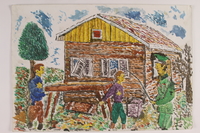
Autobiographical watercolor of two youths working under guard by a former child partisan
Object
Colorful watercolor by Arie Singer depicting himself and another boy with Judenstern carrying a table while a German soldier with a whip watches. It is from a series created by Arie Singer, circa 1985-2000, based upon his memories as a 13 year old partisan fighter in the forests near Vilna, Poland, (Vilnius, Lithuania) and Belarus circa 1943-1944. After the Soviet occupation of Vilna in late 1939, Arie's family fled to Glembokie (Hlybokaye, Belarus). When Germany invaded in June 1941, German mobile killing units, with the help of the local populace, murdered thousands of Jews. Arie and his mother were forced into the Jewish ghetto. His father, Zvi, age 38, was killed in the Ponary massacres in 1941. Arie and his mother, Chaya, age 35, escaped during liquidation of the ghetto. They went into hiding in the Nievier Forest near Vilna, and joined the partisans. The area was liberated by the Red Army in July 1944. After years in dp camps, Arie and Chaya emigrated to Israel in the late 1940s. Colonel Singer began creating this series of paintings about his Holocaust experiences in the mid 1980s as rehabilitation following a stroke in 1975.

Bisected artwork of 2 boys at a window, with 2 scenes of mass killings painted by a former child partisan
Object
Watercolor by Arie Singer depicting himself and his mother? at a window: in the right, 2 panels of the mass shooting of Jews by German soldiers. It was part of a series by Singer, done circa 1985-2000, based upon his memories as a 13 year old partisan fighter in the forests near Vilna, Poland, (Vilnius, Lithuania) and Belarus circa 1943-1944. After the Soviet occupation of Vilna in late 1939, Arie's family fled to Glembokie (Hlybokaye, Belarus). When Germany invaded in June 1941, German mobile killing units, with the help of the local populace, murdered thousands of Jews. Arie and his mother were forced into the Jewish ghetto. His father, Zvi, age 38, was killed in the Ponary massacres in 1941. Arie and his mother, Chaya, age 35, escaped during liquidation of the ghetto. They went into hiding in the Nievier Forest near Vilna, and joined the partisans. The area was liberated by the Red Army in July 1944. After years in dp camps, Arie and Chaya emigrated to Israel in the late 1940s. Colonel Singer began creating this series of paintings about his Holocaust experiences in the mid 1980s as rehabilitation following a stroke in 1975.
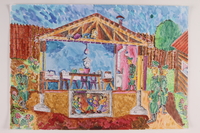
Autobiographical watercolor of Jews hiding in a house done by a former child partisan
Object
Watercolor by Arie Singer depicting his younger self hiding in an attic in Glembokie as German soldiers search a house. It was part of a series by Singer, done circa 1985-2000, based upon his memories as a 13 year old partisan fighter in the forests near Vilna, Poland, (Vilnius, Lithuania) and Belarus circa 1943-1944. After the Soviet occupation of Vilna in late 1939, Arie's family fled to Glembokie (Hlybokaye, Belarus). When Germany invaded in June 1941, German mobile killing units, with the help of the local populace, murdered thousands of Jews. Arie and his mother were forced into the Jewish ghetto. His father, Zvi, age 38, was killed in the Ponary massacres in 1941. Arie and his mother, Chaya, age 35, escaped during liquidation of the ghetto. They went into hiding in the Nievier Forest near Vilna, and joined the partisans. The area was liberated by the Red Army in July 1944. After years in dp camps, Arie and Chaya emigrated to Israel in the late 1940s. Colonel Singer began creating this series of paintings about his Holocaust experiences in the mid 1980s as rehabilitation following a stroke in 1975.
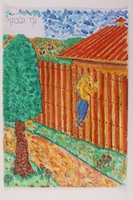
Autobiographical watercolor of a youth escaping over a fence done by a former child partisan
Object
Watercolor by Arie Singer depicting his younger self climbing over a tall wooden fence that surrounds the ghetto. It is part of a series by Singer, done circa 1985-2000, based upon his memories as a 13 year old partisan fighter in the forests near Vilna, Poland, (Vilnius, Lithuania) and Belarus circa 1943-1944. After the Soviet occupation of Vilna in late 1939, Arie's family fled to Glembokie (Hlybokaye, Belarus). When Germany invaded in June 1941, German mobile killing units, with the help of the local populace, murdered thousands of Jews. Arie and his mother were forced into the Jewish ghetto. His father, Zvi, age 38, was killed in the Ponary massacres in 1941. Arie and his mother, Chaya, age 35, escaped during liquidation of the ghetto. They went into hiding in the Nievier Forest near Vilna, and joined the partisans. The area was liberated by the Red Army in July 1944. After years in dp camps, Arie and Chaya emigrated to Israel in the late 1940s. Colonel Singer began creating this series of paintings about his Holocaust experiences in the mid 1980s as rehabilitation following a stroke in 1975.
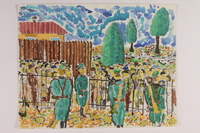
Watercolor of soldiers guarding a crowd of Jews behind a fence done by a former child partisan
Object
Watercolor by Arie Singer depicting German guards watching a large group of Jews on the other side of a fence. It is part of a series by Singer, done circa 1985-2000, based upon his memories as a 13 year old partisan fighter in the forests near Vilna, Poland, (Vilnius, Lithuania) and Belarus circa 1943-1944. After the Soviet occupation of Vilna in late 1939, Arie's family fled to Glembokie (Hlybokaye, Belarus). When Germany invaded in June 1941, German mobile killing units, with the help of the local populace, murdered thousands of Jews. Arie and his mother were forced into the Jewish ghetto. His father, Zvi, age 38, was killed in the Ponary massacres in 1941. Arie and his mother, Chaya, age 35, escaped during liquidation of the ghetto. They went into hiding in the Nievier Forest near Vilna, and joined the partisans. The area was liberated by the Red Army in July 1944. After years in dp camps, Arie and Chaya emigrated to Israel in the late 1940s. Colonel Singer began creating this series of paintings about his Holocaust experiences in the mid 1980s as rehabilitation following a stroke in 1975.

Split scene autobiographical watercolor of 2 young partisans hiding with scenes of a roundup and execution
Object
Four part scene of Aryeh hiding with a friend during a roundup and execution. It was created by Arie Singer, part of a series circa 1985-2000, based upon his memories as a 13 year old partisan fighter in the forests near Vilna, Poland, (Vilnius, Lithuania) and Belarus circa 1943-1944. After the Soviet occupation of Vilna in late 1939, Arie's family fled to Glembokie (Hlybokaye, Belarus). When Germany invaded in June 1941, German mobile killing units, with the help of the local populace, murdered thousands of Jews. Arie and his mother were forced into the Jewish ghetto. His father, Zvi, age 38, was killed in the Ponary massacres in 1941. Arie and his mother, Chaya, age 35, escaped during liquidation of the ghetto. They went into hiding in the Nievier Forest near Vilna, and joined the partisans. The area was liberated by the Red Army in July 1944. After years in dp camps, Arie and Chaya emigrated to Israel in the late 1940s. Colonel Singer began creating this series of paintings about his Holocaust experiences in the mid 1980s as rehabilitation following a stroke in 1975.
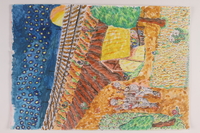
Autobiographical watercolor of Aryeh and other Jews in hiding
Object
Watercolor by Arie Singer of his 13 year old self, Aryeh, hiding in a cabin as an SS patrol walks nearby. It was created by Singer, part of a series circa 1985-2000, based upon his memories as a 13 year old partisan fighter in the forests near Vilna, Poland, (Vilnius, Lithuania) and Belarus circa 1943-1944. After the Soviet occupation of Vilna in late 1939, Arie's family fled to Glembokie (Hlybokaye, Belarus). When Germany invaded in June 1941, German mobile killing units, with the help of the local populace, murdered thousands of Jews. Arie and his mother were forced into the Jewish ghetto. His father, Zvi, age 38, was killed in the Ponary massacres in 1941. Arie and his mother, Chaya, age 35, escaped during liquidation of the ghetto. They went into hiding in the Nievier Forest near Vilna, and joined the partisans. The area was liberated by the Red Army in July 1944. After years in dp camps, Arie and Chaya emigrated to Israel in the late 1940s. Colonel Singer began creating this series of paintings about his Holocaust experiences in the mid 1980s as rehabilitation following a stroke in 1975.

Autbiographical watercolor of wounded soldiers being taken through a village
Object
Colorful watercolor by Arie Singer depicting a white horse pulling a wagon with wounded, or possibly poisoned, per the artist, Russian soldiers past people wearing Star of David badges. It is from of a series circa 1985-2000, based upon his memories as a 13 year old partisan fighter in the forests near Vilna, Poland, (Vilnius, Lithuania) and Belarus circa 1943-1944. After the Soviet occupation of Vilna in late 1939, Arie's family fled to Glembokie (Hlybokaye, Belarus). When Germany invaded in June 1941, German mobile killing units, with the help of the local populace, murdered thousands of Jews. Arie and his mother were forced into the Jewish ghetto. His father, Zvi, age 38, was killed in the Ponary massacres in 1941. Arie and his mother, Chaya, age 35, escaped during liquidation of the ghetto. They went into hiding in the Nievier Forest near Vilna, and joined the partisans. The area was liberated by the Red Army in July 1944. After years in dp camps, Arie and Chaya emigrated to Israel in the late 1940s. Colonel Singer began creating this series of paintings about his Holocaust experiences in the mid 1980s as rehabilitation following a stroke in 1975.me years in a displaced persons camps, Arie and Chaya emigrated to Israel in the late 1940s. Colonel Singer began creating this series of paintings about his Holocaust experiences in the mid 1980s as rehabilitation following a stroke in 1975.
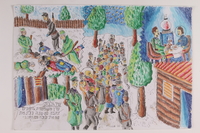
Scenes from the life of a Jewish woman painted by Arie Singer
Object
Colorful watercolor by Arie Singer depicting 3 scenes with the same woman: having dinner, being rounded up by soldiers, laying dead, shot by soldiers. It is part of a series circa 1985-2000, based upon his memories as a 13 year old partisan fighter in the forests near Vilna, Poland, (Vilnius, Lithuania) and Belarus circa 1943-1944. After the Soviet occupation of Vilna in late 1939, Arie's family fled to Glembokie (Hlybokaye, Belarus). When Germany invaded in June 1941, German mobile killing units, with the help of the local populace, murdered thousands of Jews. Arie and his mother were forced into the Jewish ghetto. His father, Zvi, age 38, was killed in the Ponary massacres in 1941. Arie and his mother, Chaya, age 35, escaped during liquidation of the ghetto. They went into hiding in the Nievier Forest near Vilna, and joined the partisans. The area was liberated by the Red Army in July 1944. After years in dp camps, Arie and Chaya emigrated to Israel in the late 1940s. Colonel Singer began creating this series of paintings about his Holocaust experiences in the mid 1980s as rehabilitation following a stroke in 1975.



